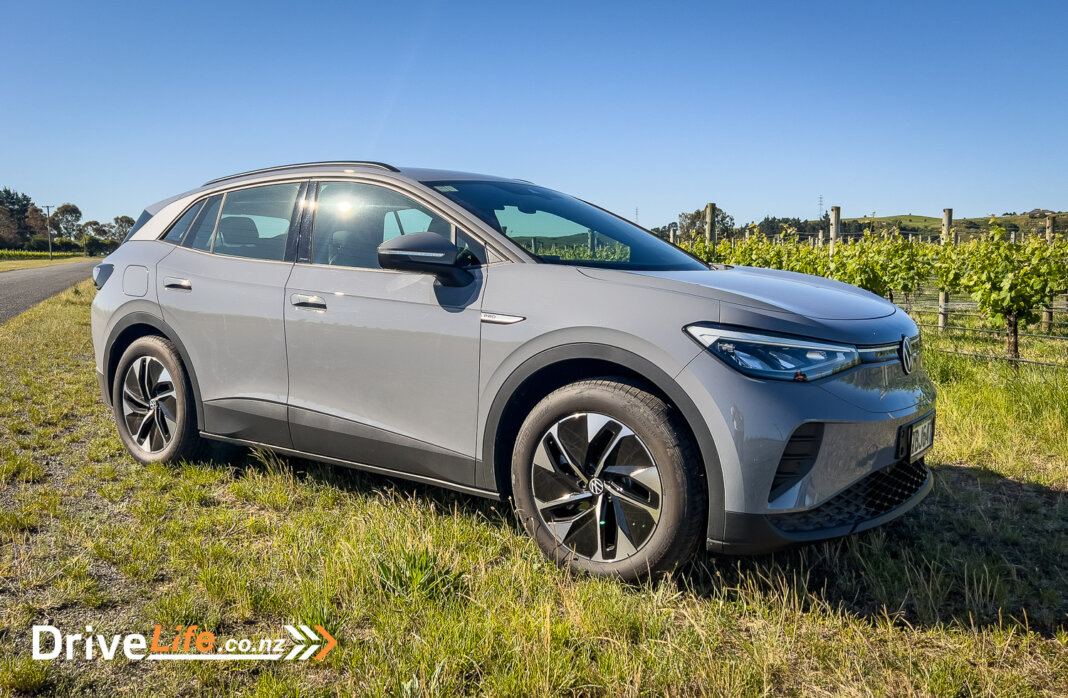Volkswagen as a brand has seemed to have run in my family. I’ve owned two, my wife one, and growing up my Dad also had two. To me, they are kind of like a European Toyota; nothing fancy, no wild design, and nothing to dislike. They are solid, dependable and just do the job.
With their investment in electric vehicles across the ID range, I was keen to see if this was still the case and how they stacked up in this segment. One week and 900km later, it was an interesting conclusion.
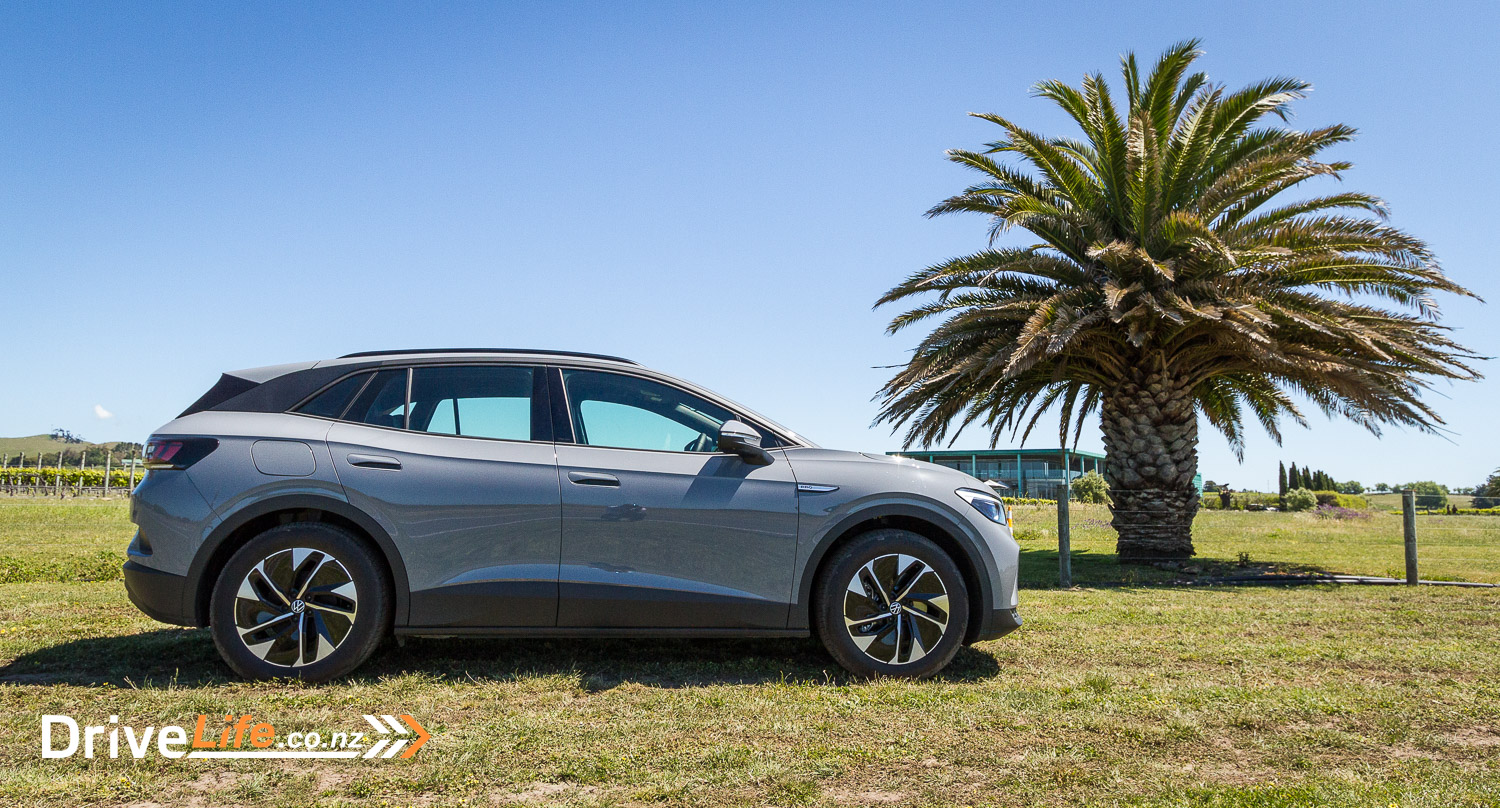
What We Like and Dislike About The 2023 Volkswagen ID.4 PRO
| What we like | What we don’t like |
| Great driving range Clean, simple, and functional modern interior Solid build quality Attractive price point | Touchscreen controls not polished Front seats are not electric Apple CarPlay via cable only |
What’s In The 2023 Volkswagen ID.4 Range?
The Volkswagen ID.4 comes in a pretty standard spec for this size SUV. You get 150Kw / 310Nm from a single electric motor driven through the rear wheels. Battery capacity is a respectable 77kWh. Sound familiar? More on that later.
The interesting thing here is that when I first heard I would be trying the ID.4, I went to Volkswagen’s website and downloaded the spec sheet, which was for the model year 2023 and includes the up speced ID.4 PRO+ variant. However, when writing the review, I noticed the spec sheet has been updated to model year 2024 and the PRO+ is no longer listed as available.
I enquired with the local dealer who assured me it was still available, despite there being no mention of it in any official material anymore. I am still waiting on confirmation that this is the case and as such I will only concentrate on the PRO and not list what you could have had. If you want a higher spec, take a look at the ID.5, which is still available in the PRO+ variant.
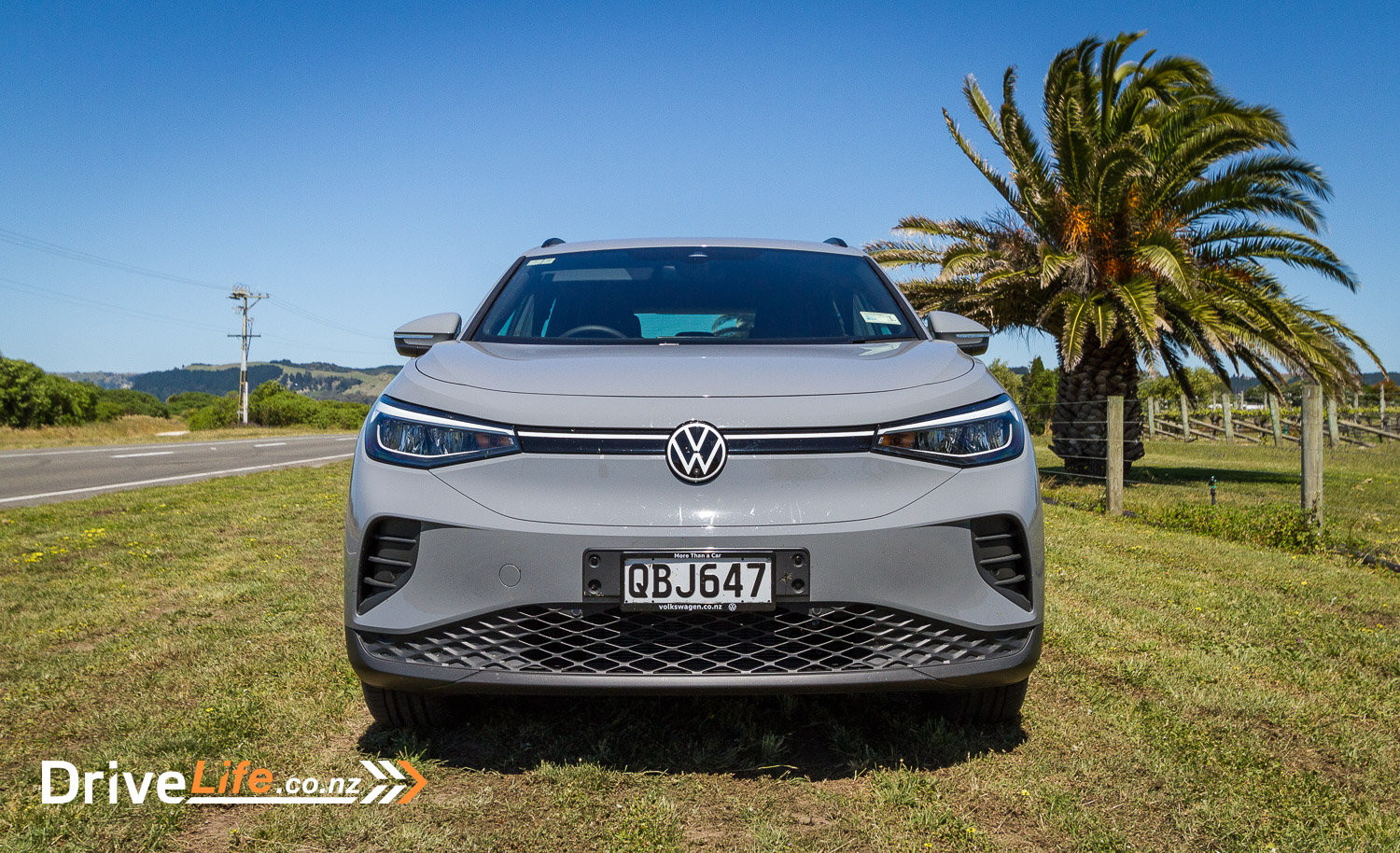
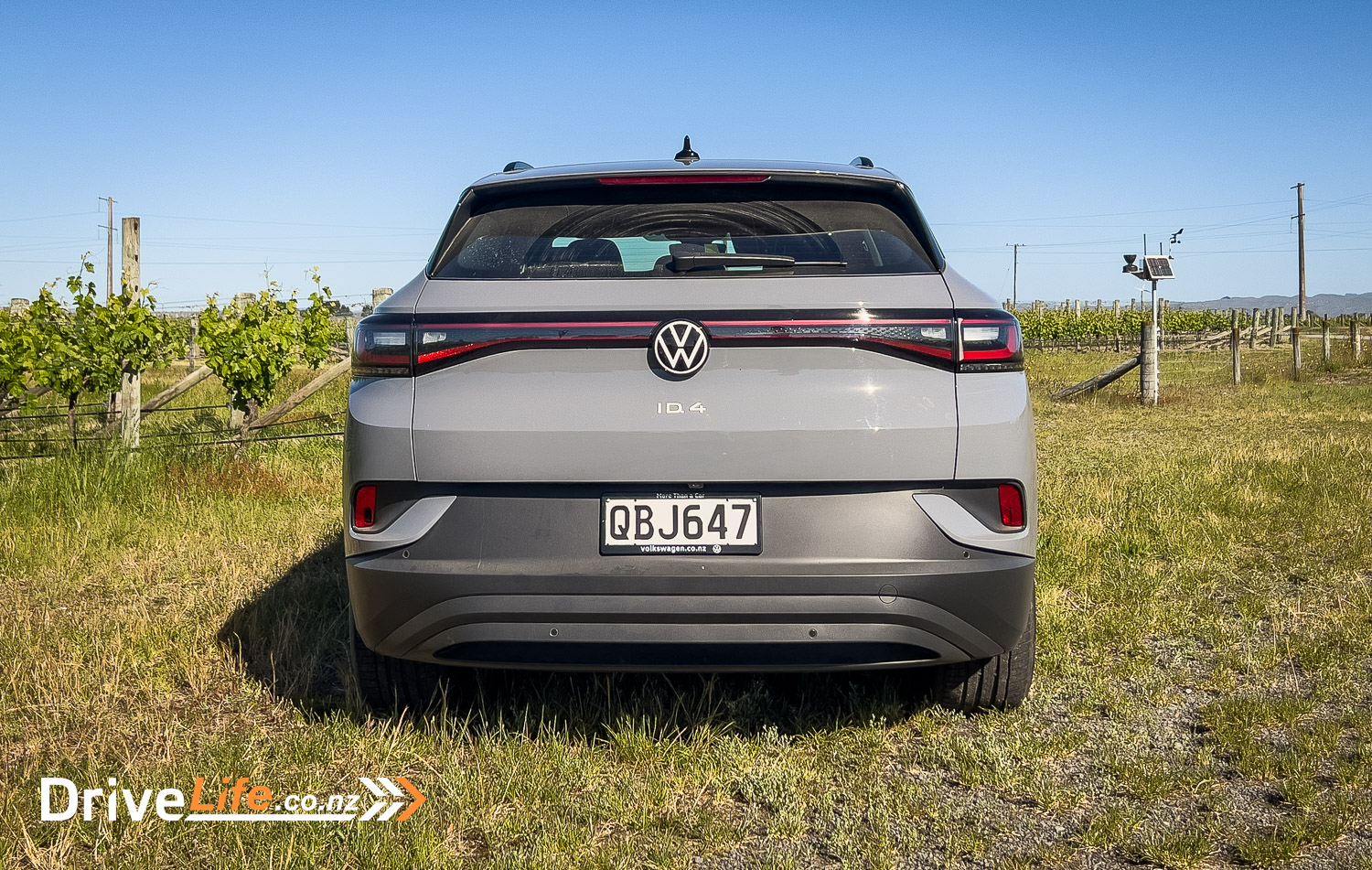
2023 Volkswagen ID.4 Standard Equipment Highlights
- Multi-Link rear suspension
- Driving Profile Selection (Eco, Comfort, Sport and Individual)
- Standard LED Headlights with headlight range adjustment
- LED Daytime Running Lights (DRL)
- Low light sensor with automatic headlight function
- ID. Exclusive LED puddle lights
- Standard LED Combination tail lamps
- Body-coloured exterior side mirrors (power-folding, adjustable & heated)
- Green-tinted heat-insulating windows (Sides and rear)
- Roof rails
- “KESSY” – Smart Key, push-button start and keyless locking without SAFELOCK
- Electronic parking brake with Auto hold
- Climatronic 2-zone air conditioning system
- Leather-covered multifunction steering wheel with heated function
- ID. Exclusive “Twist & Go” function
- Automatic dimming interior rear-view mirror
- ID. Exclusive “Play & Pause” brushed stainless steel pedals
- 30-Colour Ambient Lighting
- Variable luggage compartment
- ‘ArtVelours’ microfleece front seats
- Heated front seats
- “Ready 2 Discover” Infotainment System:
- 10″ TFT-LCD Colour touch-screen
- Bluetooth® phone connectivity and audio streaming
- 5.3″ TFT-LCD Multi-function Digital Instrument cluster
- Wireless charger (Qi-enabled devices only)
- Tyre Mobility Set
If you cruise on up to your local Volkswagen dealer hoping to spec out your new ID.4, it’s going to be a pretty short meeting. You have one option, the ID4 Pro, and the only thing you get to individualise is the colour. Here you have a choice of 6, and there is no price premium for them. Those available are:
- Blue Dusk Metallic
- Glacier White Metallic
- Grenadilla Black Metallic
- Kings Red Metallic
- Moonstone Grey
- Scale Silver Metallic
The retail price of our review car is $79,990
For a full list of specs and options available for the BRAND ID.4 PRO head on over to the Volkswagen New Zealand website
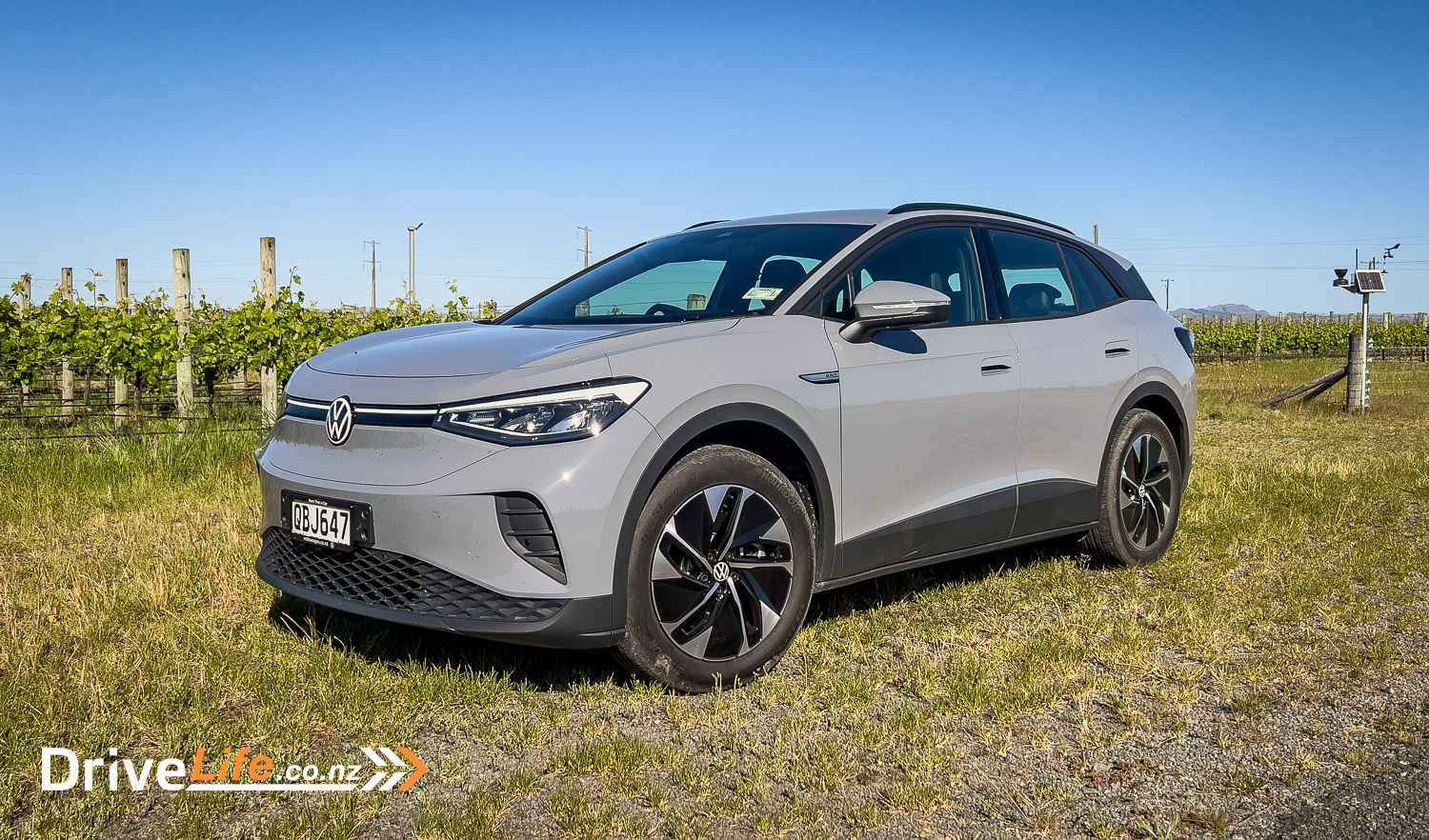
How Does The 2023 Volkswagen ID.4 PRO Compare To Its Competition?
Comparing the ID.4 to its competition is an interesting exercise, particularly since the Volkswagen group is not only using its MEB electric platform across its multiple brands but also making it available to its competition outside the group in various states of supply.
So far Ford has picked this up for the Explorer EV, but has not announced dates or even if this will be released in New Zealand, the only comment being “it won’t be anytime soon”, which was made in March 2023.
If you stay within the Volkswagen group for this platform, you have the Audi Q4 e-tron -40 Advanced, Skoda Enyaq, and Volkswagen ID.4, all of which are essentially mechanically the same vehicle, but with different visual styles, driver technology, and target audiences. The Volkswagen and Skoda both come in at the same price, whilst the Audi commands a $25,000 premium.
Fred drove the Max version of the Skoda last year and was impressed with it. Rightly so as it made it into the top ten for New Zealand Car Of The Year. You can read his thoughts here. We also have the Audi q4 e-tron coming up for review very soon, so you should be able to get a great overview of the group’s offerings in this segment.
The electric SUV segment is getting very competitive, especially in New Zealand with our obsession with SUVs and the growing popularity of EVs on the market. The table below should give you some overview of what is available across the segment.
| Make / Model | Battery Capacity kW-hr | Power/ Torque kW/Nm | 0-100km/h seconds | Range (WLTP) | Boot Space, litres | Price |
| Audi Q4 e-tron – 40 Advanced | 82 | 150 / 310 | 8.5 | 511 | 512 | $99,990 |
| Volvo C40 Recharge | 78 | 170 / 660 | 7.4 | 438 | 414 | $87,990 |
| Skoda Enyaq Sportline Max (RWD) | 82 | 150 / 310 | 8.6 | 544 | 585 | $84,990 |
| Volkswagen ID.4 | 77 | 150 / 310 | 8.5 | 519 | 543 | $79,990 |
| 2022 Opel Mokka-e | 50 | 100 / 260 | 9.2 | 363 | 310 | $69,990 |
| MG ZS EV | 50 | 130 / 280 | 8.2 | 320 | 359 | $53,990 |
Please note DriveLife does its best to ensure the information below is correct at the time of publication, however, prices and models can change over time. Please bear that in mind when comparing models in the comparison table.
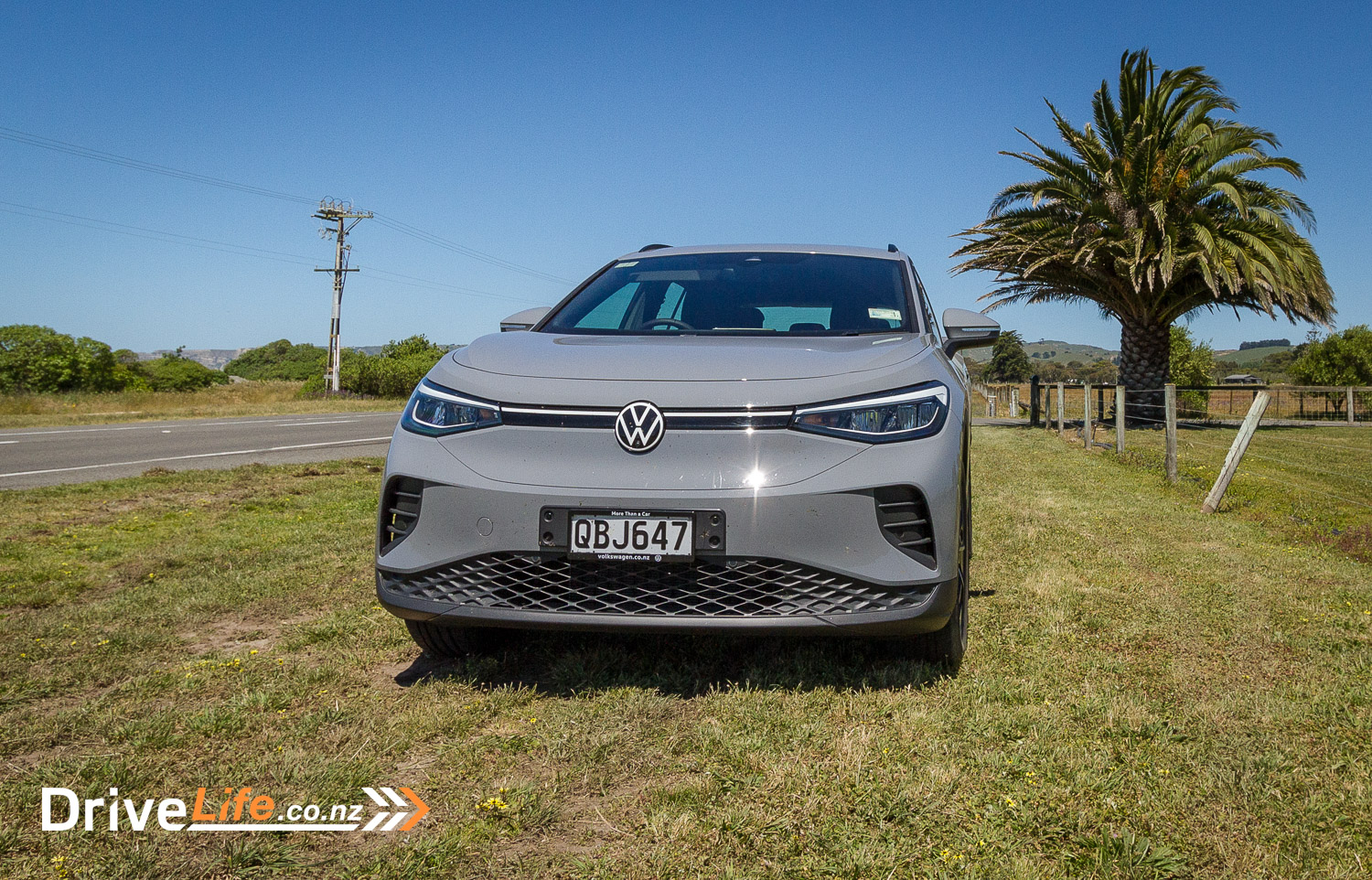
First Impressions Of The 2023 Volkswagen ID.4 PRO
As previously mentioned, I had been looking forward to spending some time in a Volkswagen EV, and when I first saw the ID.4 in the flesh these feelings were reinforced. To me, Volkswagen is not pushing the limits of design, but what they do is very aesthetically pleasing. The ID.4 fits the bill with nice contours, a good profile, and proportions that work. It is instantly recognisable as a Volkswagen, and that’s not a bad thing similar to Porsche, which hardly ever changed the main contours and lines on the 911.
My test model was in the Moonstone Grey option; this is a “plastic” look paint that probably doesn’t show off the vehicle in its best light, and the only thing that was slightly off-putting with the design to me. However, I did see some other examples in the dealership in the blue and red that looked great.
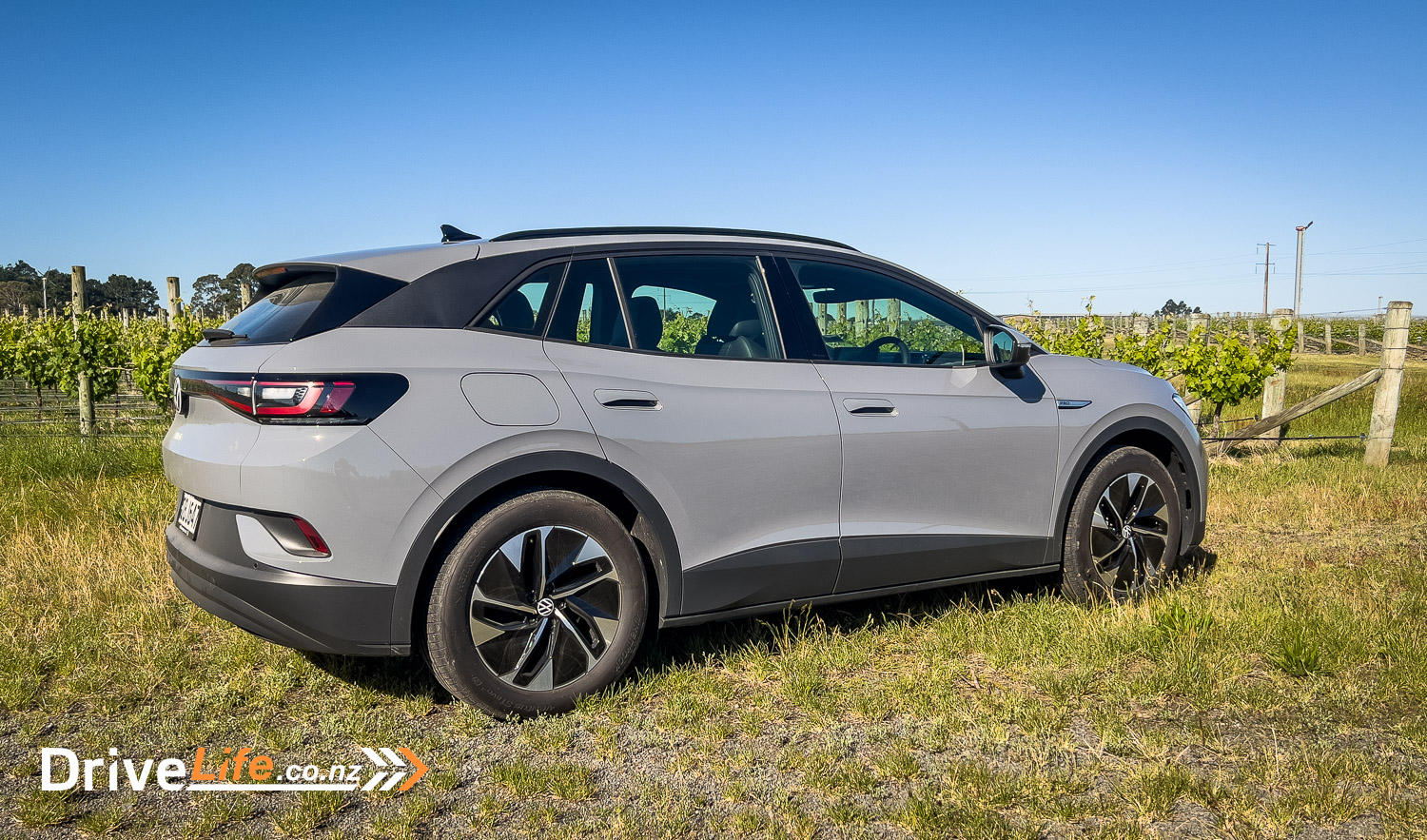
What’s The Interior Like In The 2023 Volkswagen ID.4 PRO?
When you open the door and step inside, the ID.4 gets even more noticeably Volkswagen.
The door cards themself are nice with lots of areas defined by different materials. The very top, however, where they roll over to the window, appears to be the same plastic material and pattern on my previous two Volkswagens, a 2004 Golf Mk5, and a 2009 Mk6 GTi. This same material appears to be used in multiple places throughout the interior, and I was surprised by this.
Forgetting about this and moving on, I liked the interior. It had that feeling of being at home, safe and comfortable, which could be emphasised by my history of owning Volkswagens. As well as this standard Volkswagen patterned plastic, the interior is made up of both high gloss and silver plastic. It’s nicely designed, assembled well, and is more angular in its design than round.
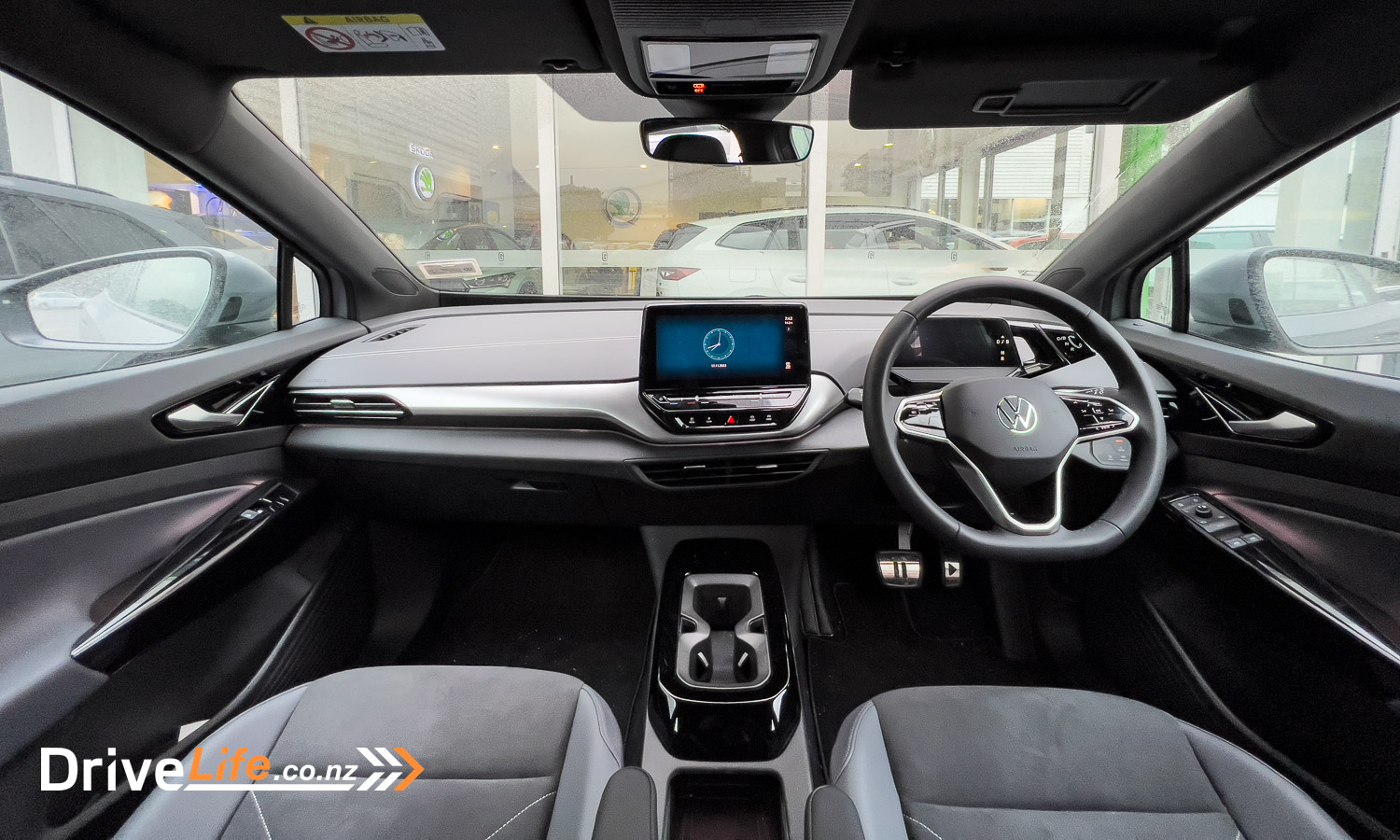
In the ID.4, Volkswagen has made a point of having a lot of controls being touch-based as opposed to traditional mechanically activated controls. Makes sense for an electric vehicle right? Except you need to implement it well, and in the ID.4 it is pretty hit or miss.
On the driver’s door interior, you have the standard controls and some extras. For the wing mirrors you have a standard rotary control knob to adjust the mirror position. To select the mirror to control however, you have a touch-sensitive area to choose either left or right, but no feedback to tell you which mirror you have selected. Likewise, you have touch areas for rear door child locks, overall locking of the doors, and both folding in the wing mirrors and turning on the heating function in them. All great to have but again they sometimes worked, sometimes didn’t, and the only feedback was a slight light in the icons, that required a distraction from the driver.
The really bad one however was the windows. Instead of having four switches to move them up or down, you have two (left or right) and a touchpad in front of them that, if selected, converts them to operate on the rear window. This caught me out a lot as when moving your hand down to operate a switch, you would inadvertently activate the touchpad and find yourself operating the rear windows. This was the only touch area in the vehicle that appeared super sensitive, and I found it frustrating.
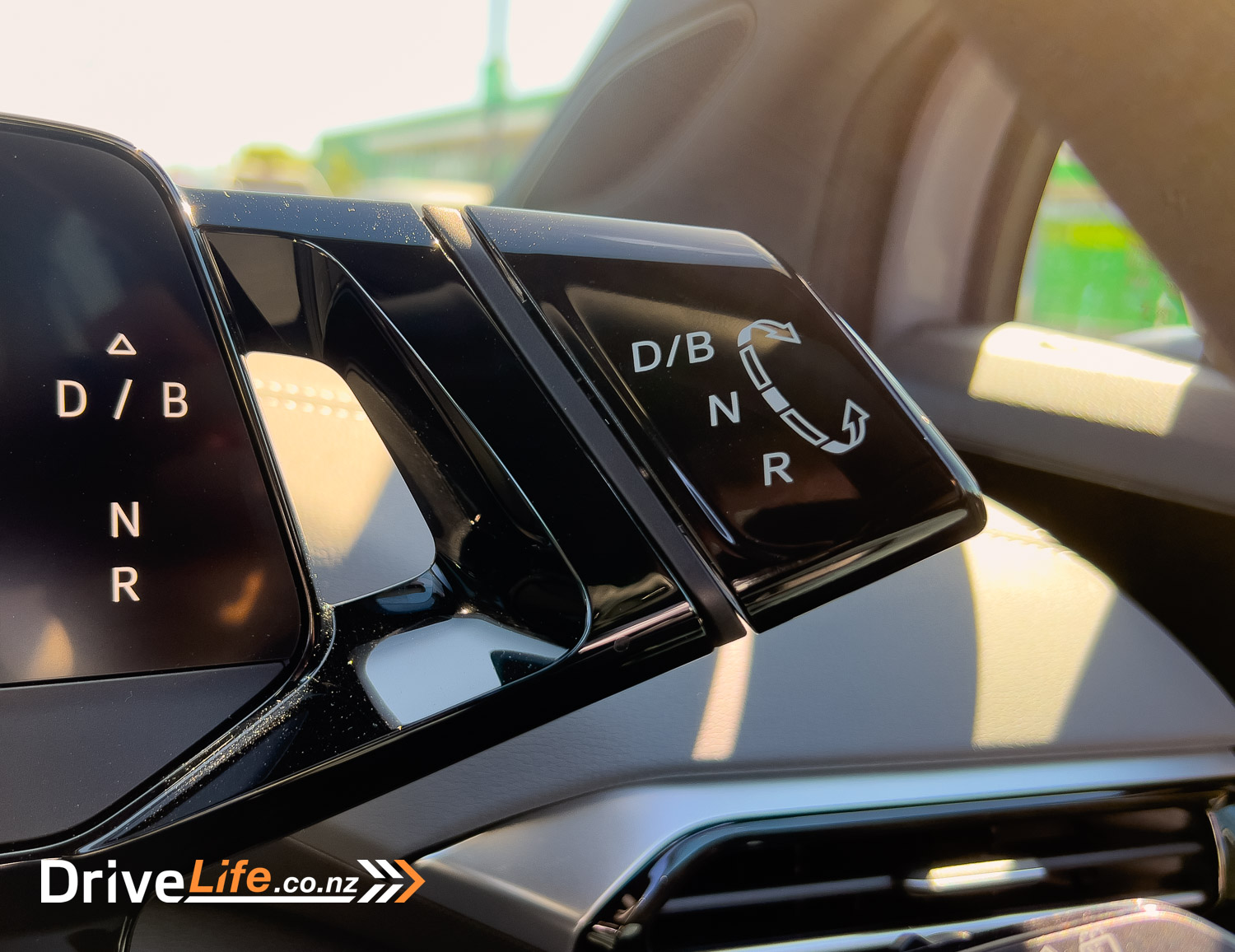
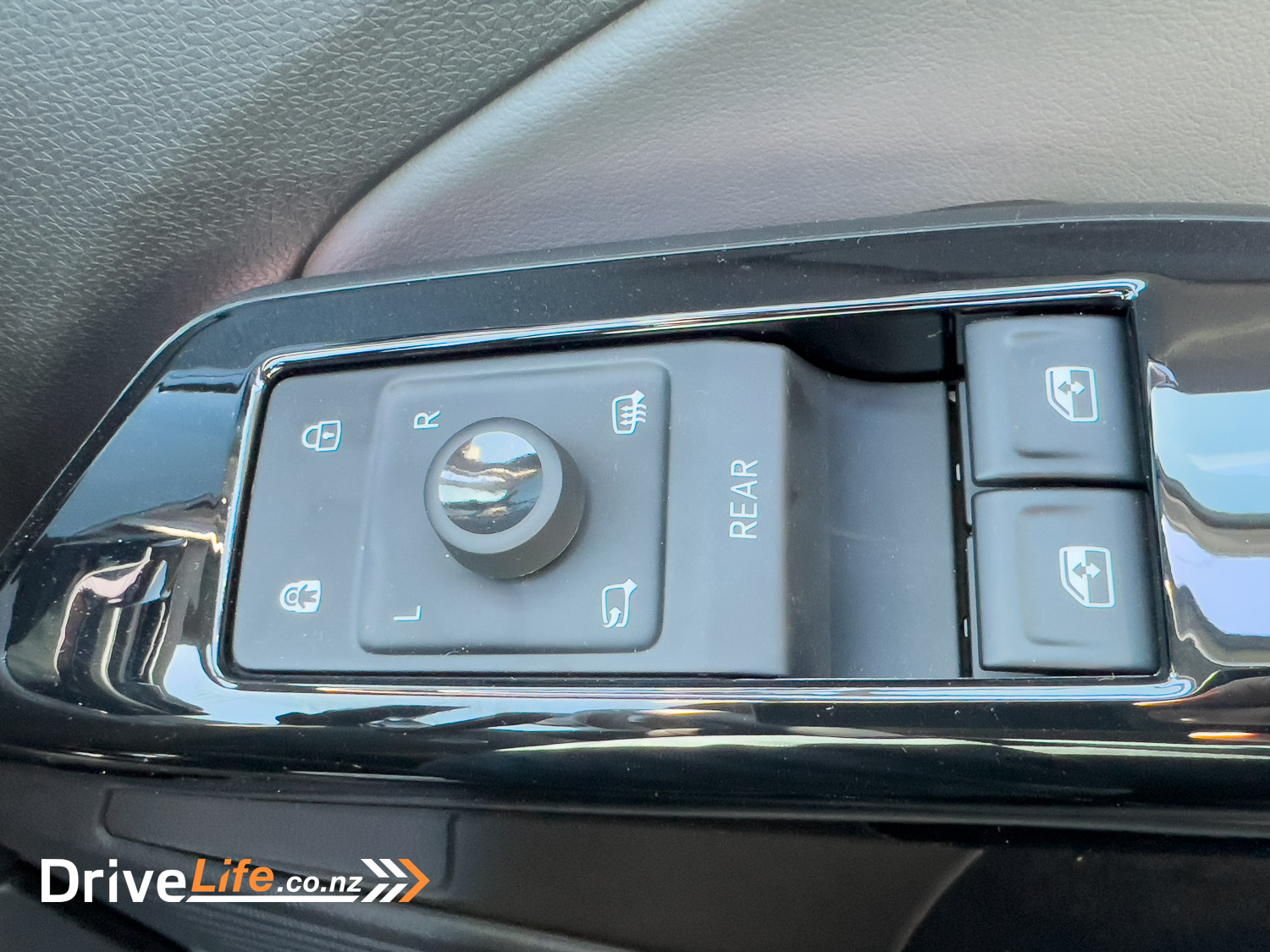
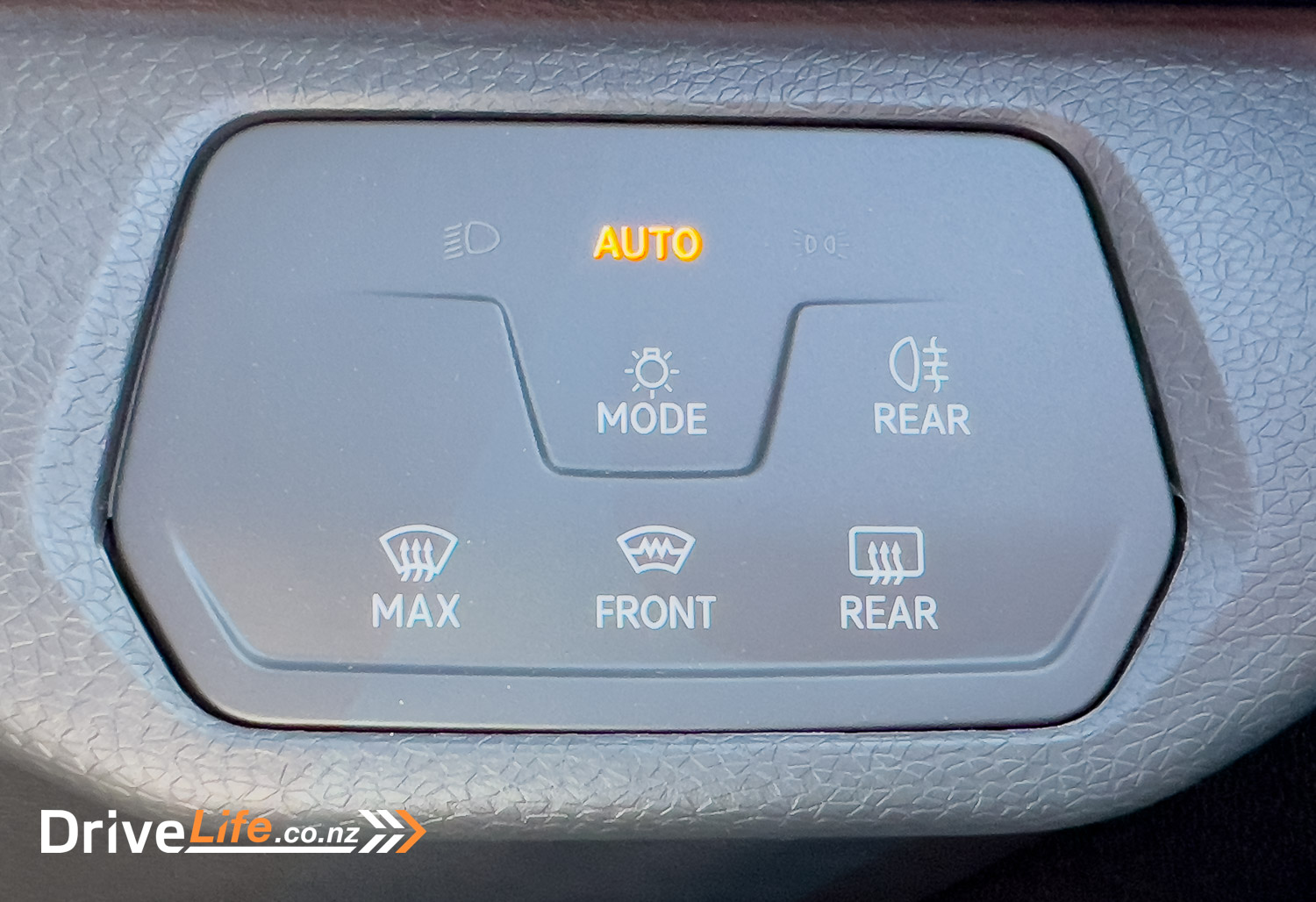
Once in the ID.4, you find yourself in a comfortable seat. They are contoured nicely, have a good range of adjustment and look the part. Material wise they are a light grey leatherette on the outsides and dark grey microfleece on the inner. Contrasting white stitching complements them well and gives a modern but conservative look. The only negative with the seats is the lack of electric adjustability. I know I am going to sound like a broken record, but $80,000 is a lot of money to be spending, and having manual seats doesn’t cut it with me. This was the same issue with the Cupra born. Not even having an upgrade option is also strange. To get them you will need to go to the ID.5 and get the PRO+ variant.
When occupying the driver’s seat, you have a standard but nice Volkswagen steering wheel in front. It’s a good diameter with a slightly flat bottom and is contoured nicely for your hands. Either side of the spokes on the wheel features various controls for the infotainment and main dashboard. These again were touch controls and I again found them difficult to use. Whilst the dealer gave me a quick demo when picking up the car, and made it look super simple, I could never replicate the ease at which he was able to navigate, with my gestures only appearing to get recognised 30% of the time. The worst culprit was the lower section of each side, which are used to swipe through menu settings on the main dash (right side) or the central display (left side). Above these, the controls to set and select things were more accurate, but I found myself physically pressing them as opposed to swiping. This seems to be a common issue as we experienced the exact same issue with the Cupra Born.
The driving position was great, I could easily adjust the seat and steering wheel combination to find a position that worked well for me and was comfortable on both short and long drives.
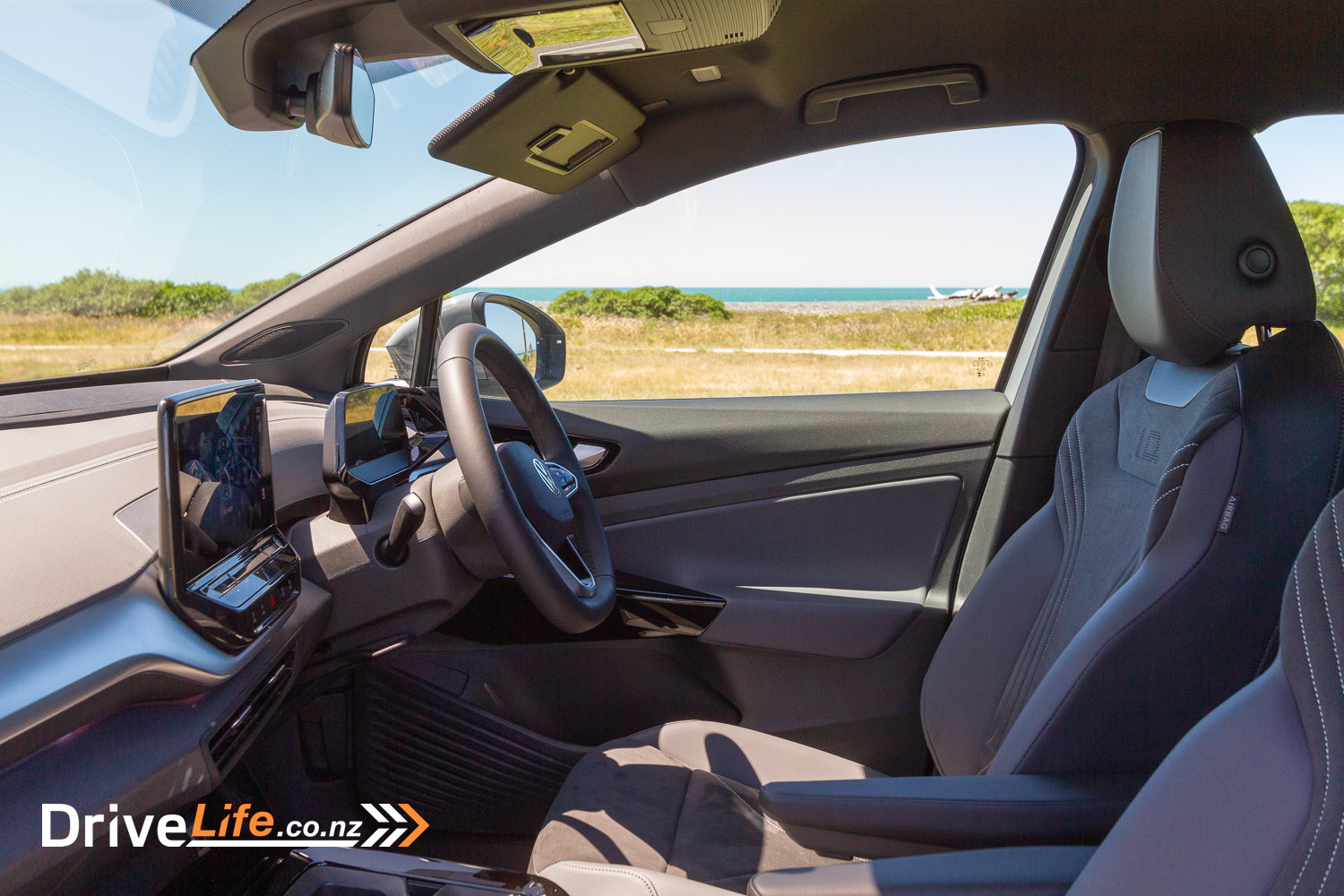
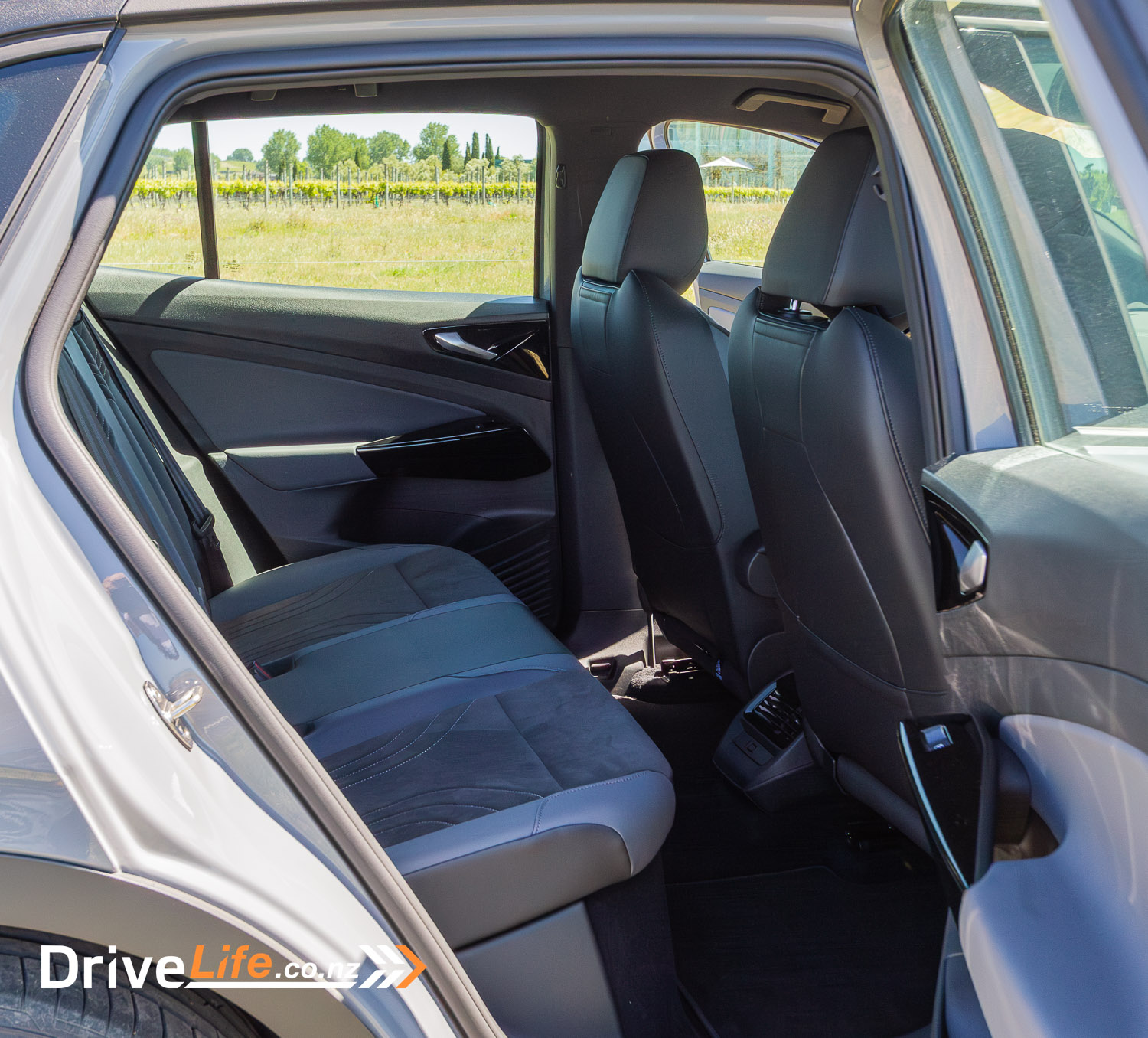
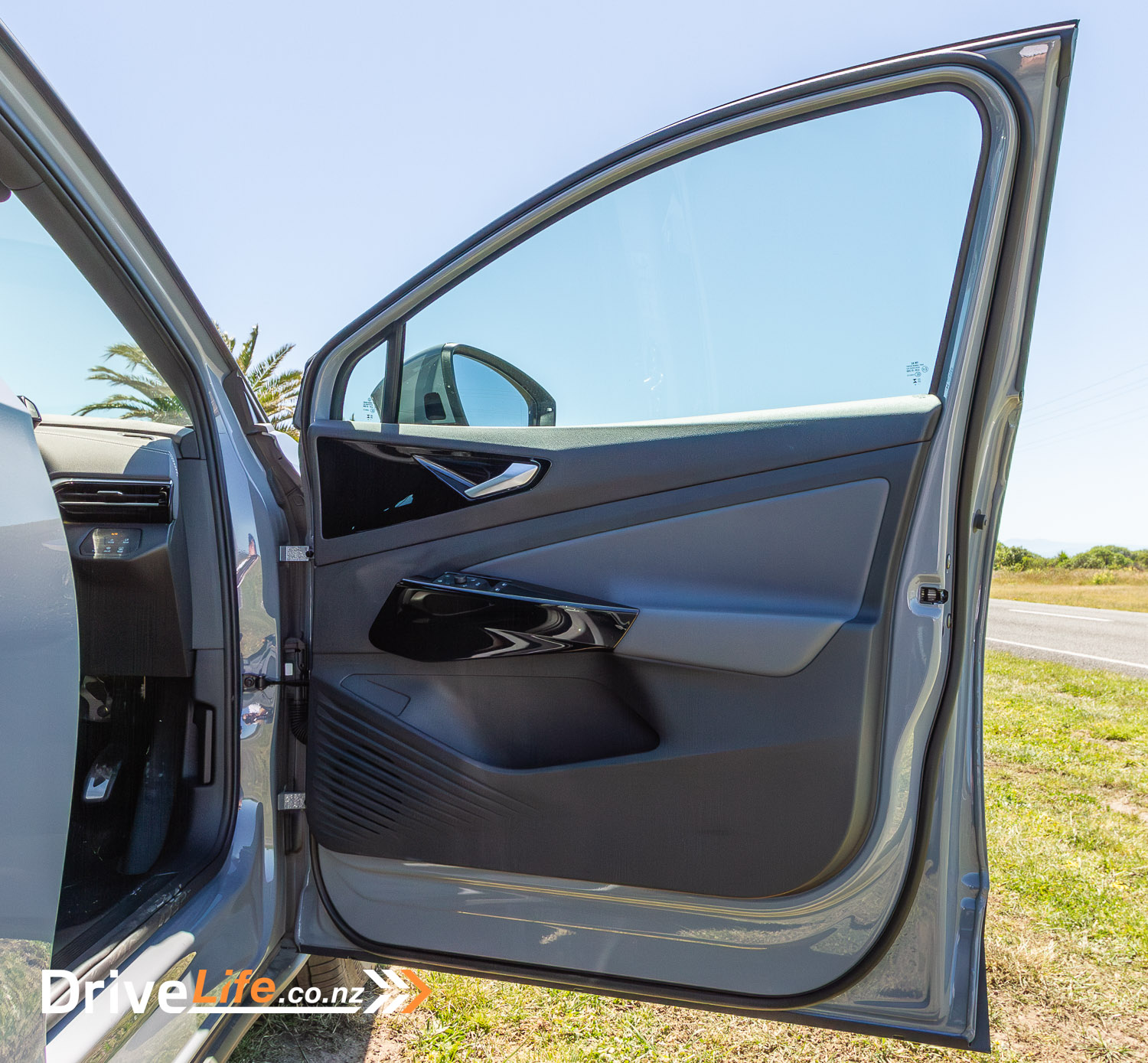
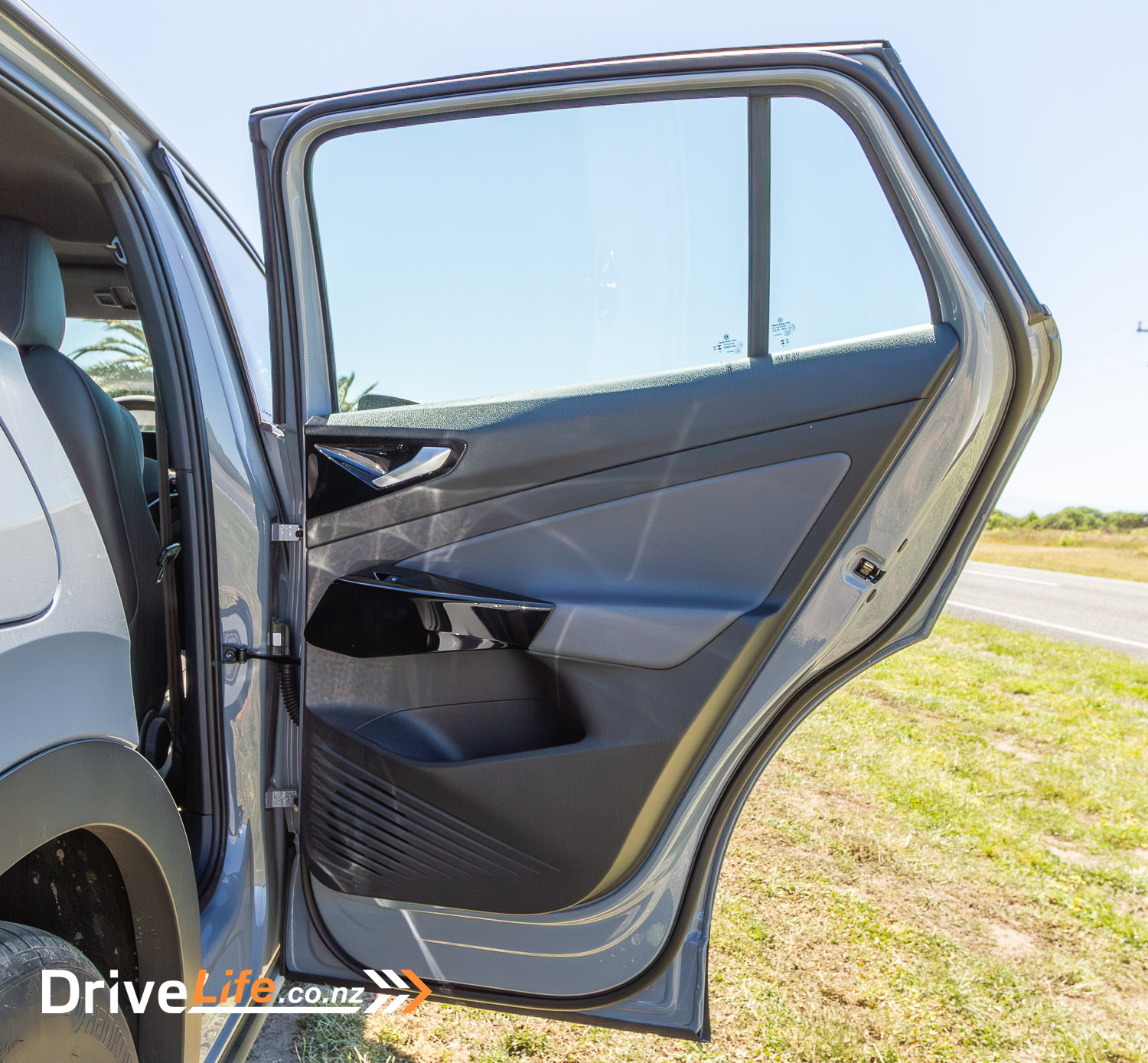
Behind the steering wheel is a small 10-inch dashboard that shows your driving information through different screens and is very clear and easy to read. I did however think it was perhaps a little too small and aesthetically looked out of place due to this size. It did show all the information you need so it served its purpose well. The small island-type design is a nice departure from a lot of the instrument clusters we see today however the control stalk out to the right did not integrate well design-wise.
For your infotainment purposes, in the centre of your dashboard, you have a reasonably sized 10-inch touch screen. Again I thought this could benefit from being a little larger, and on the ID.5 Pro+ this is the case.
The screen itself was nice and clear, even in bright sunlight. I found the system a bit clunky and not the best UI. All the buttons are a common blue colour which results in having to spend more time identifying what you would like to press. The graphics on each button are also not that distinctive which also makes them harder to identify at a glance. With more time in the vehicle, I’m sure you will build up muscle memory and this will speed up, but for someone new to it it was distracting and slow.
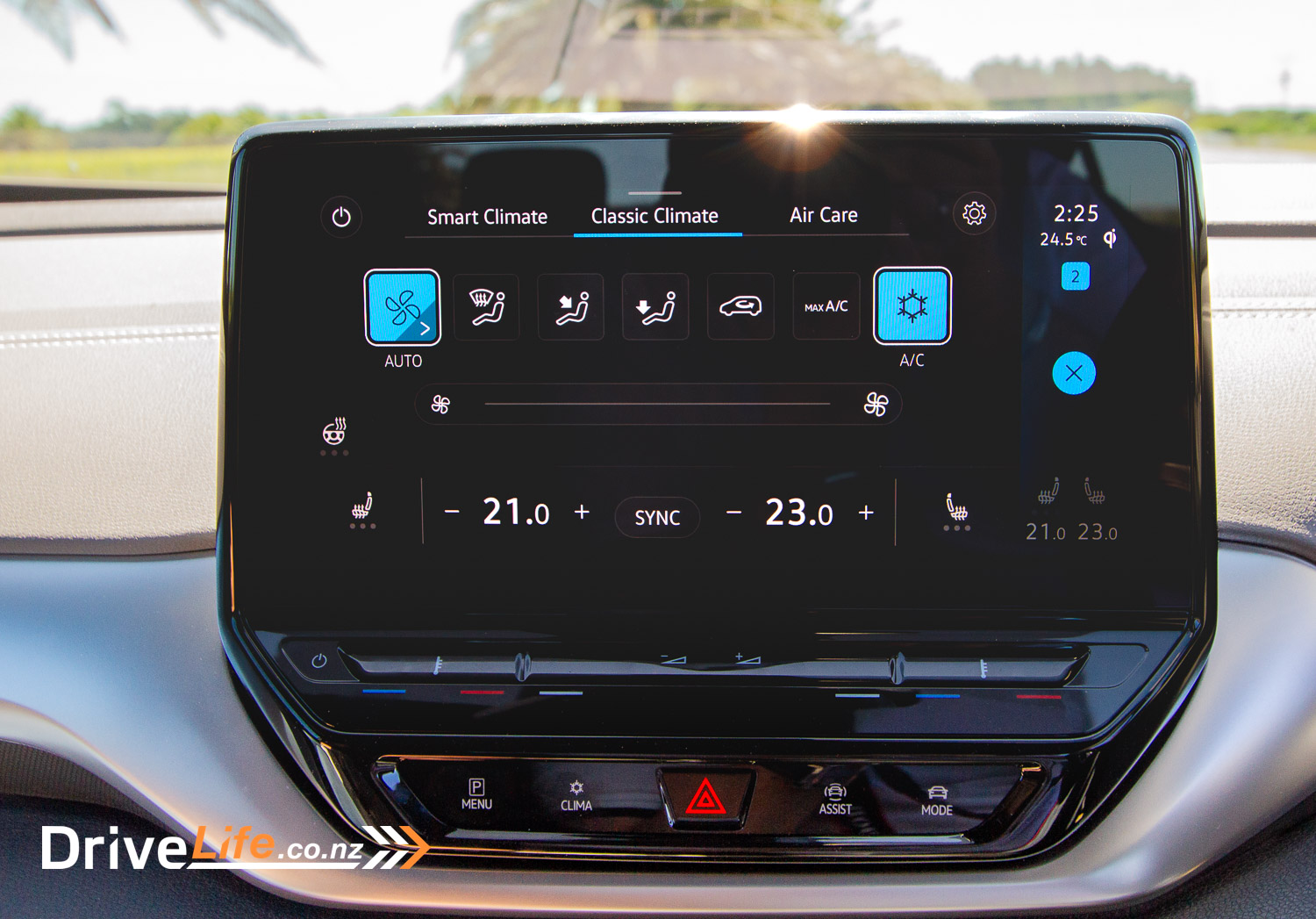
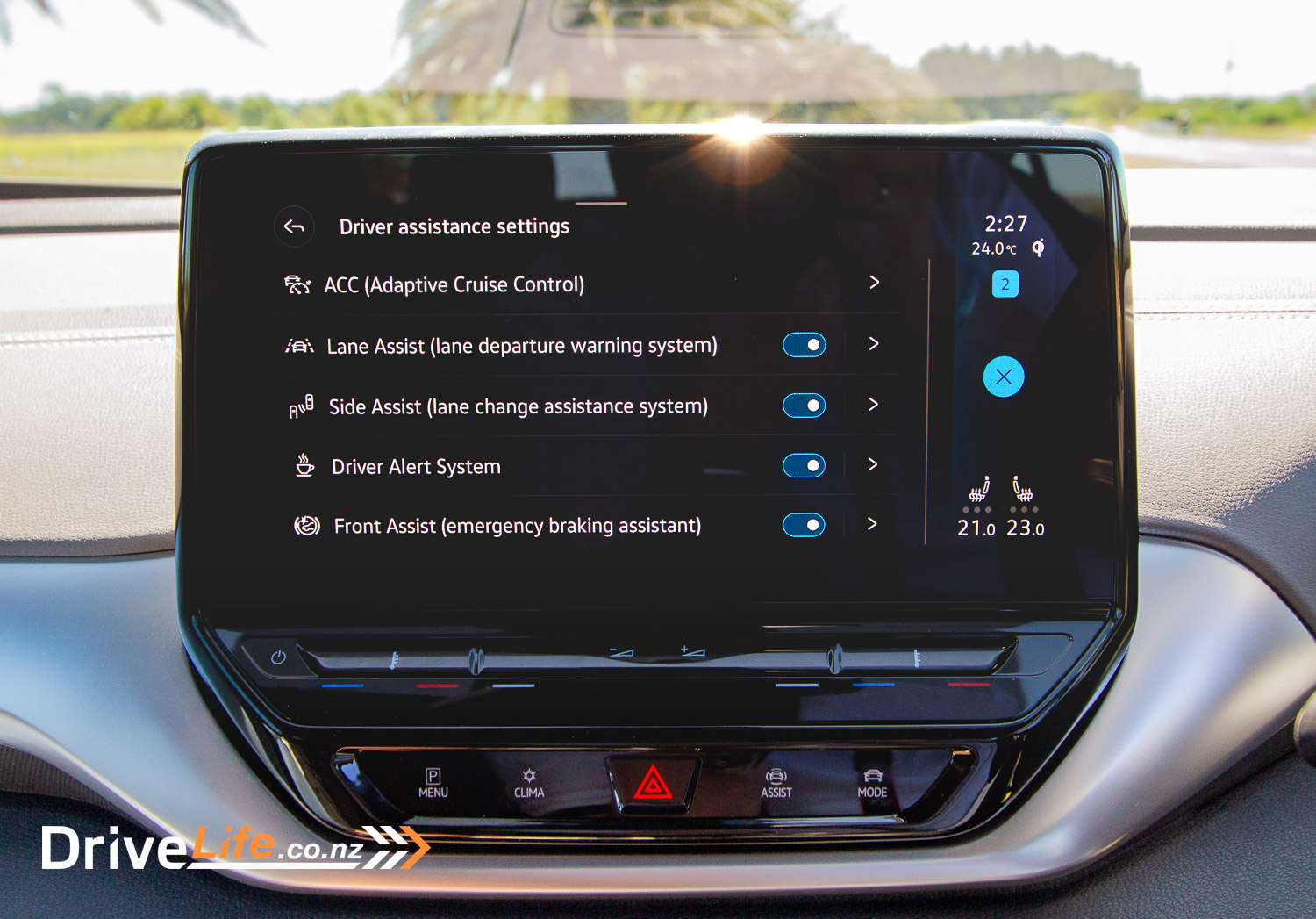
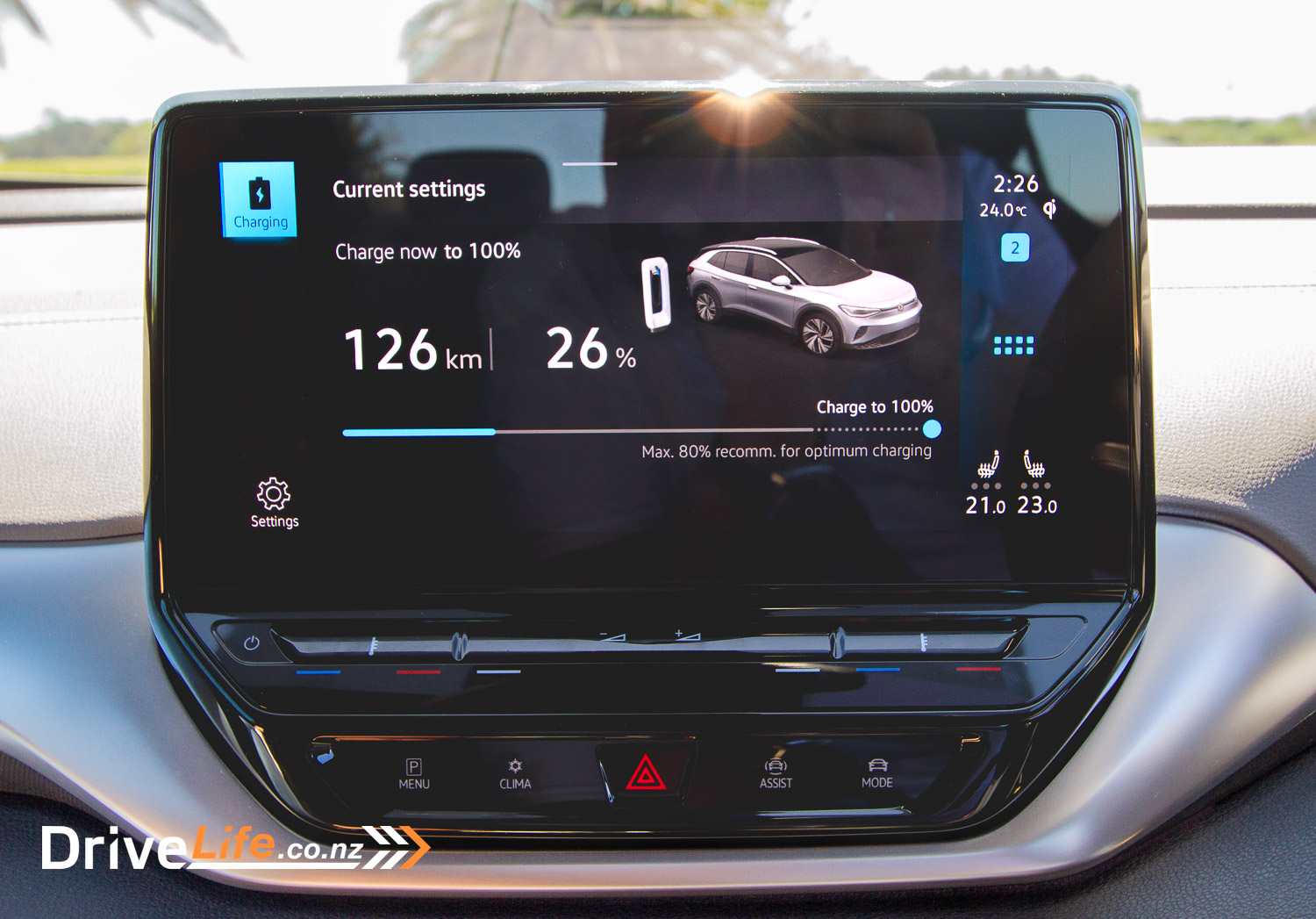
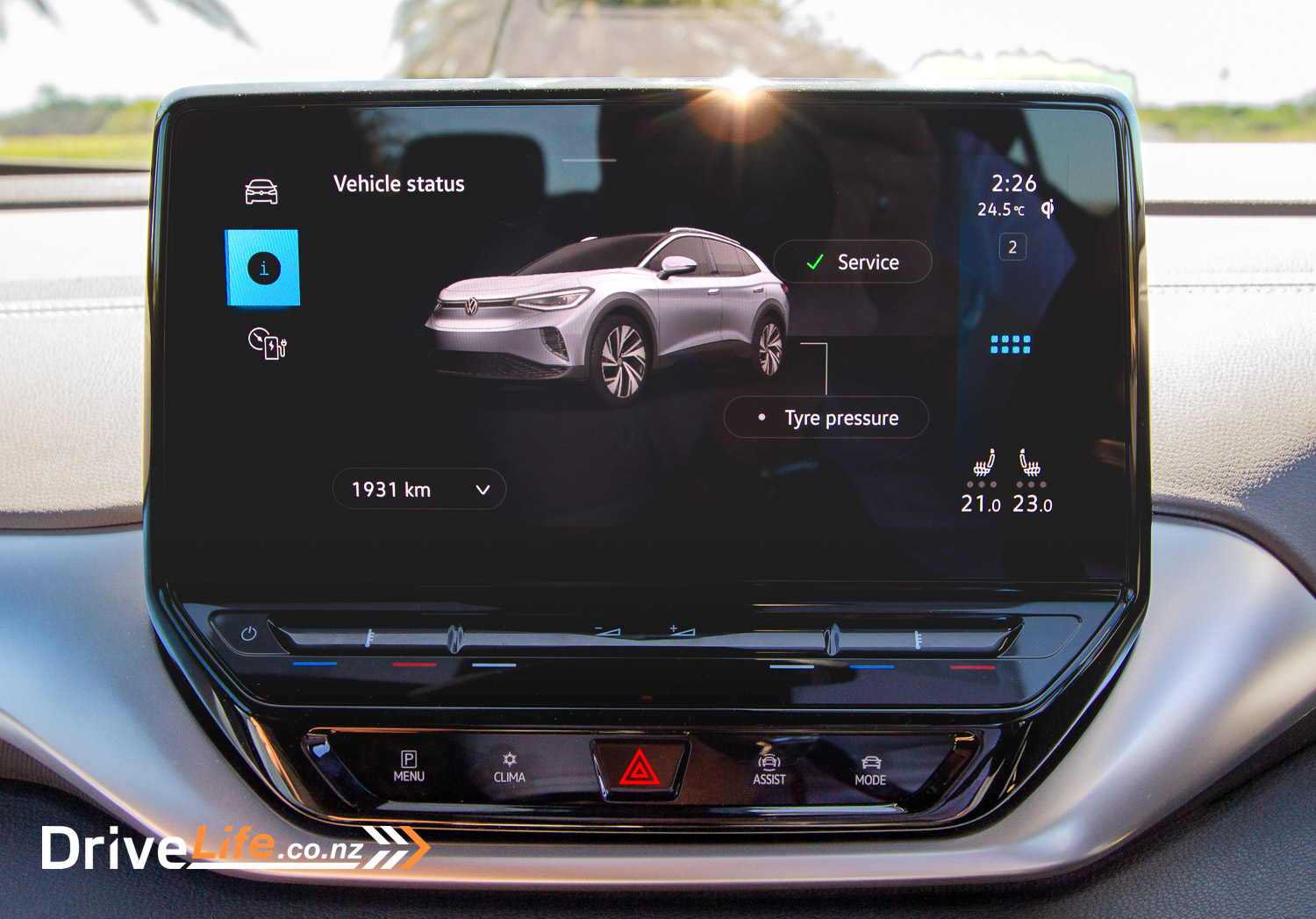
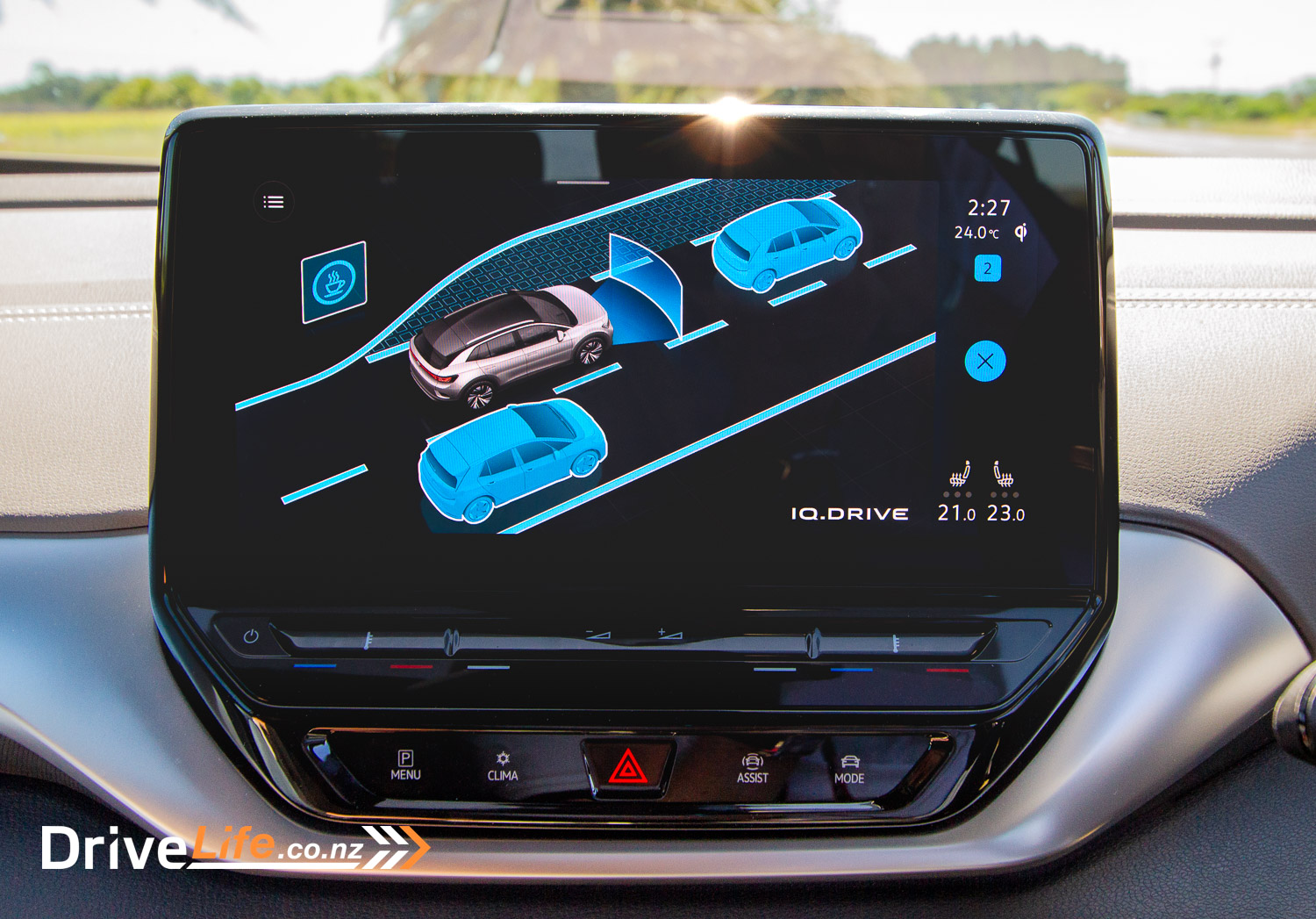
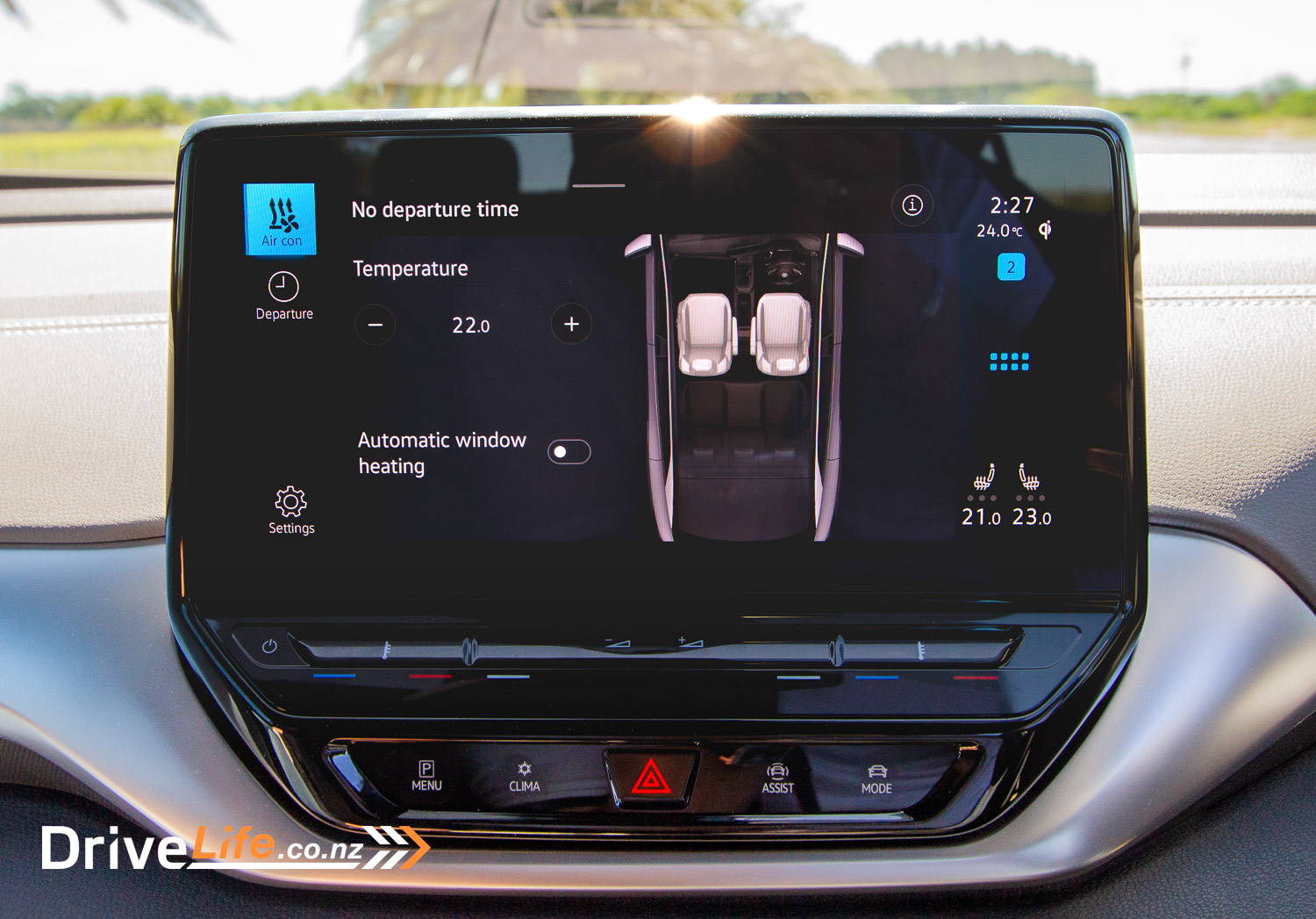
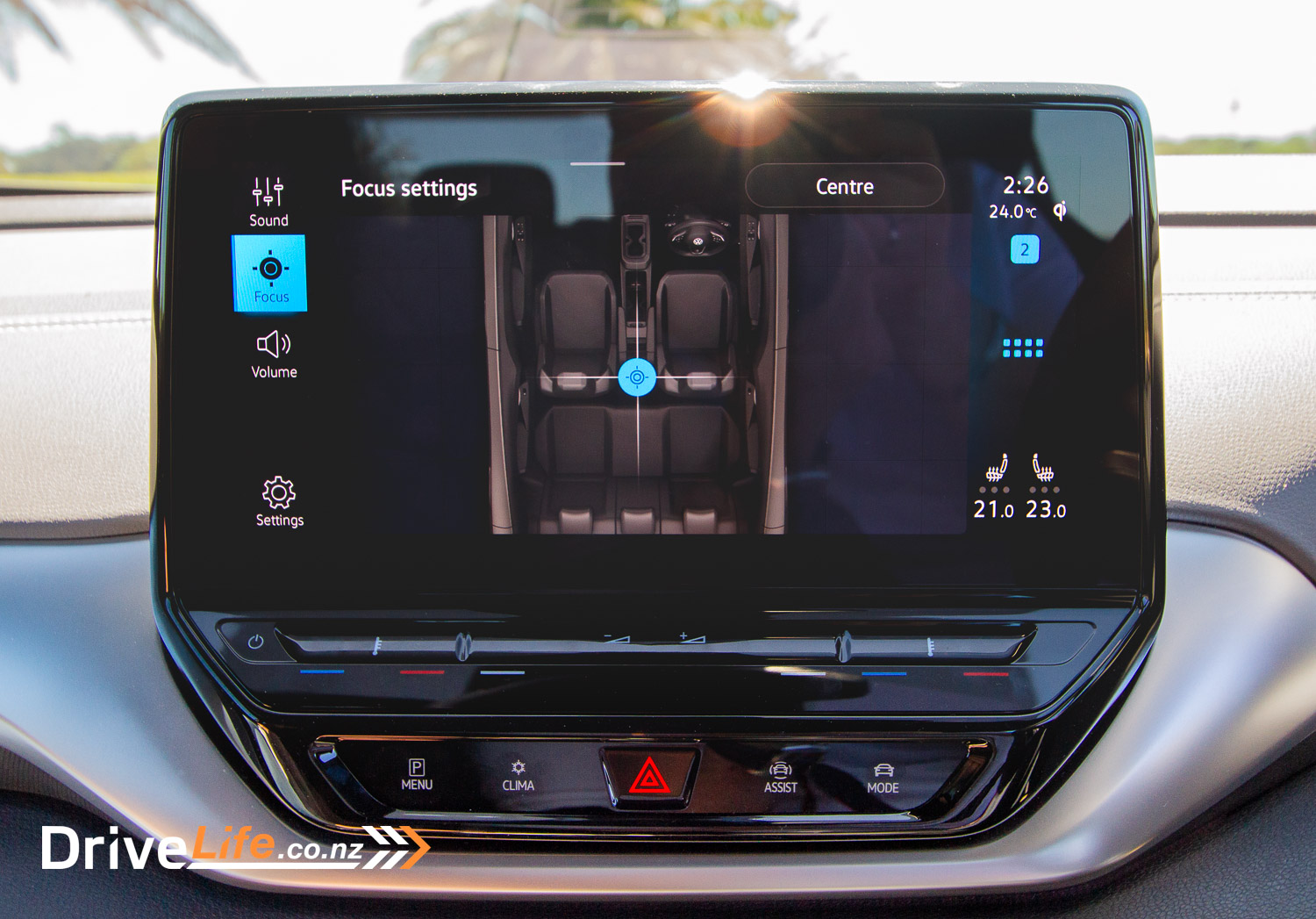
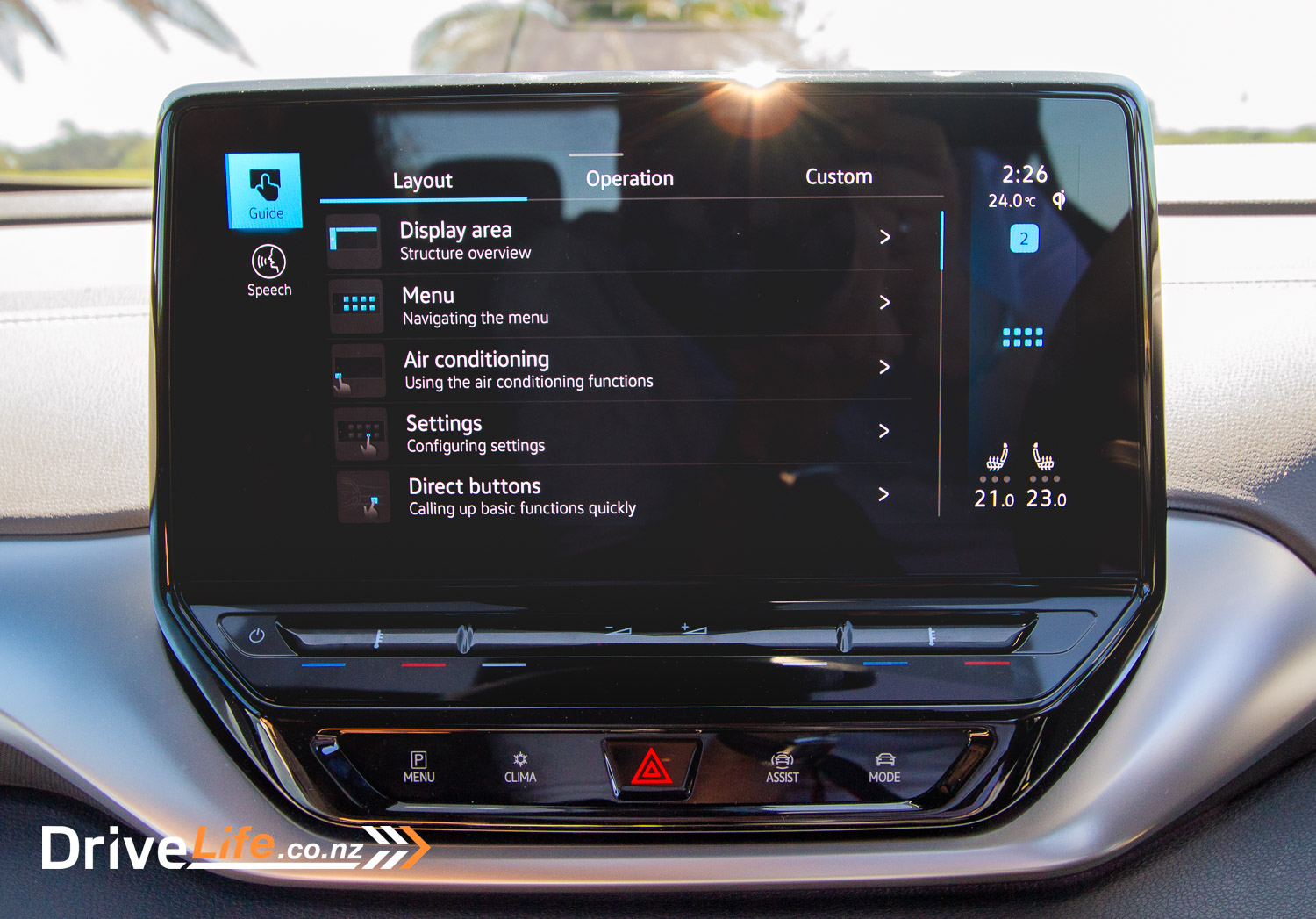
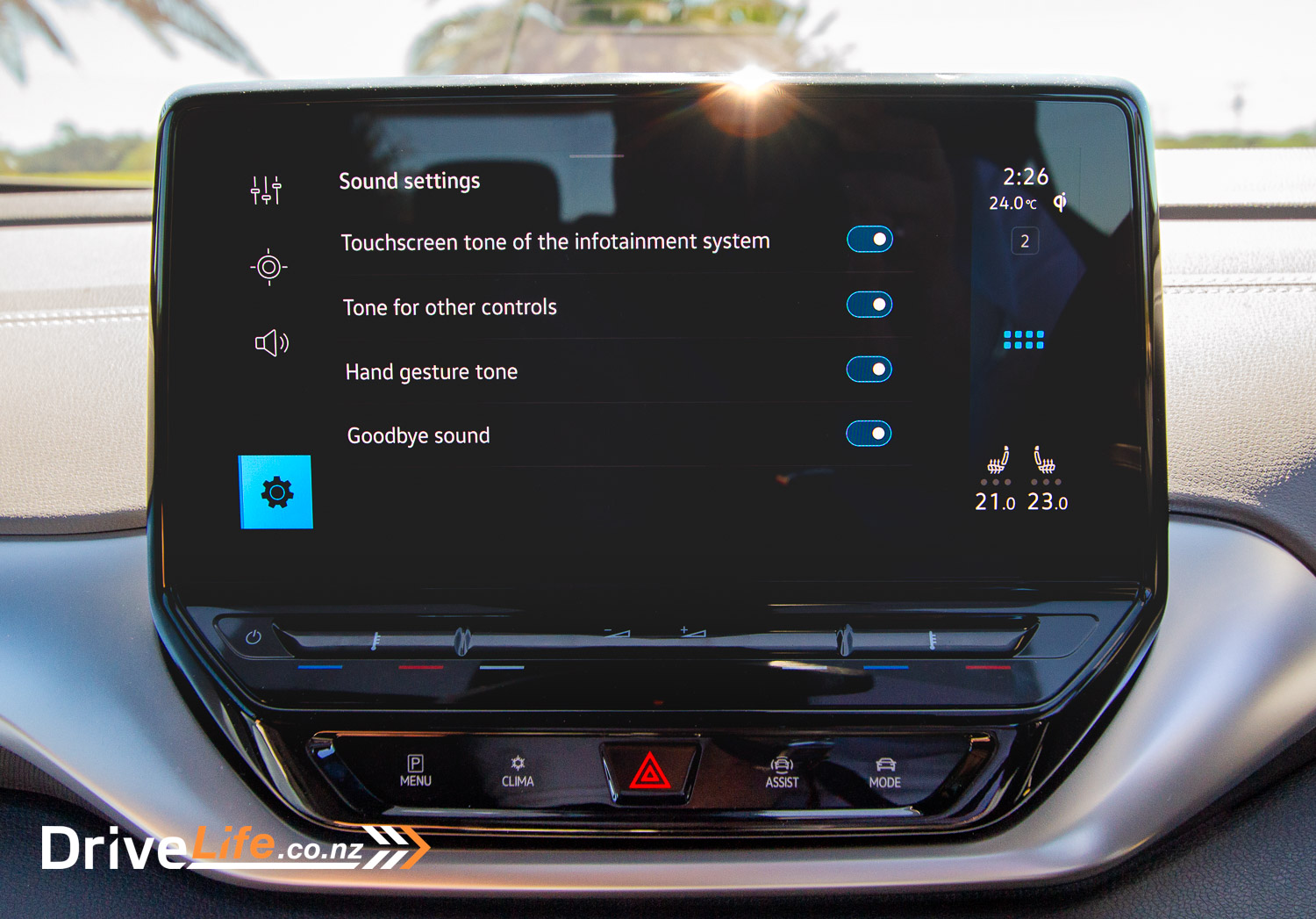
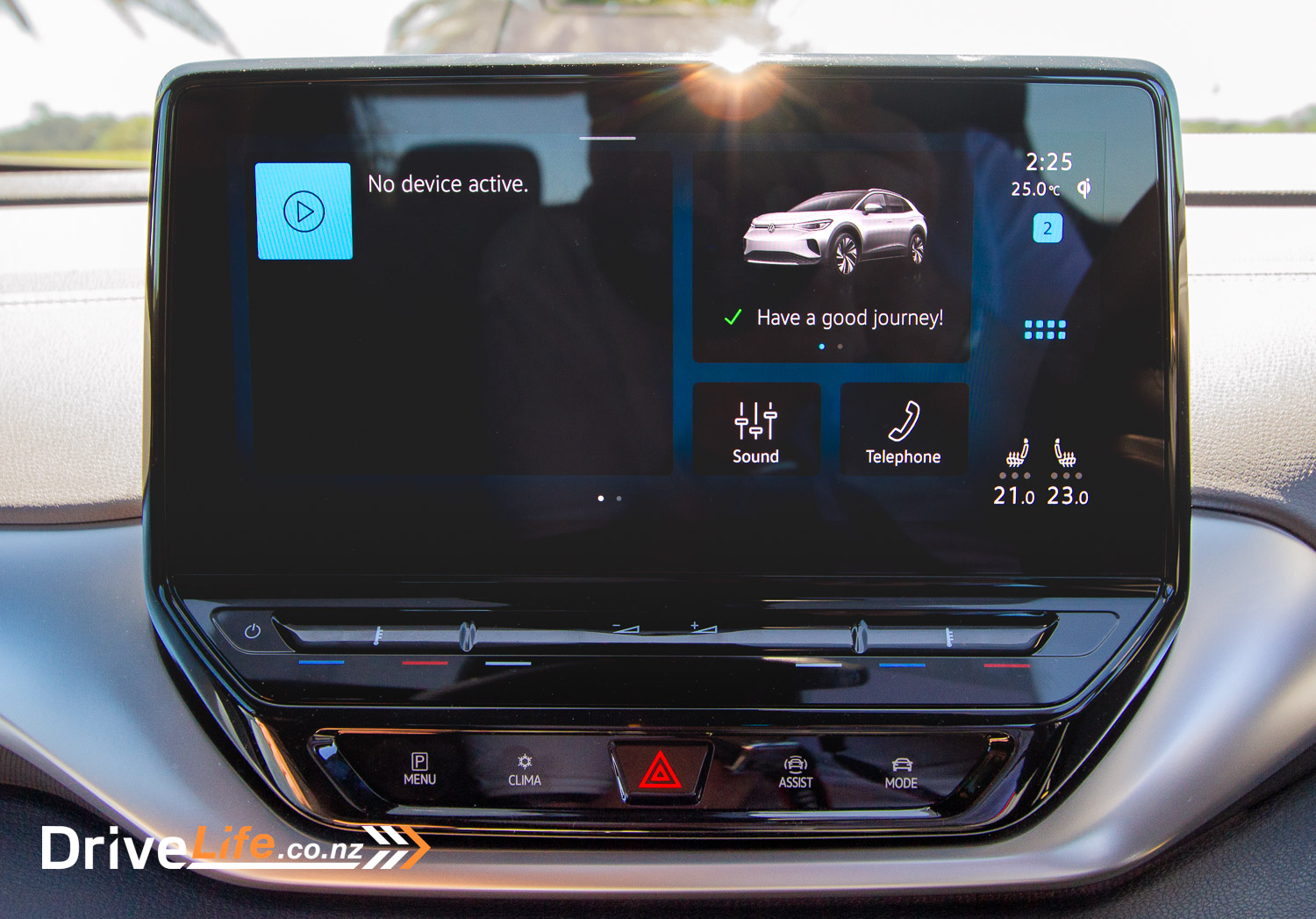
Once you are over the UI issues, the functions available are good and cover all you require. They do however often require a bit of digging down into the system to find. Again a pain for a newcomer but something that will improve over time for an owner. One glaring omission, which is becoming more common, is no proprietary navigation system; Instead, Volkswagen relies on the use of Apple CarPlay or Android Auto, again unfortunately only available with a wired connection.
Below the central touchscreen, you have a small section of touch buttons that provide shortcuts to common features. Directly below the screen, you have a volume control in the centre, which you can swipe left or right to decrease and increase. This worked pretty well. On either side of it you have temperature control for the respective side’s air conditioning. Below this, you have shortcut buttons for the parking menu, climate control, driving assistance options, and driving modes. A nice touch (no pun intended) that starts to alleviate the UI issues previously mentioned.
The final feature of the dashboard is the glove box, and again unfortunately have taken the increasingly common option of a full-width door, but only a half-width container behind it.
The centre console between the front seats features two generously sized cup holders up front, then a sliding cover section at the rear, which when opened features a Qi charging pad, dual USB-C connectors, and a generous storage cubby. To the rear of this, for the benefit of the back seat passengers, you have two more USB-C ports and dual air vents.

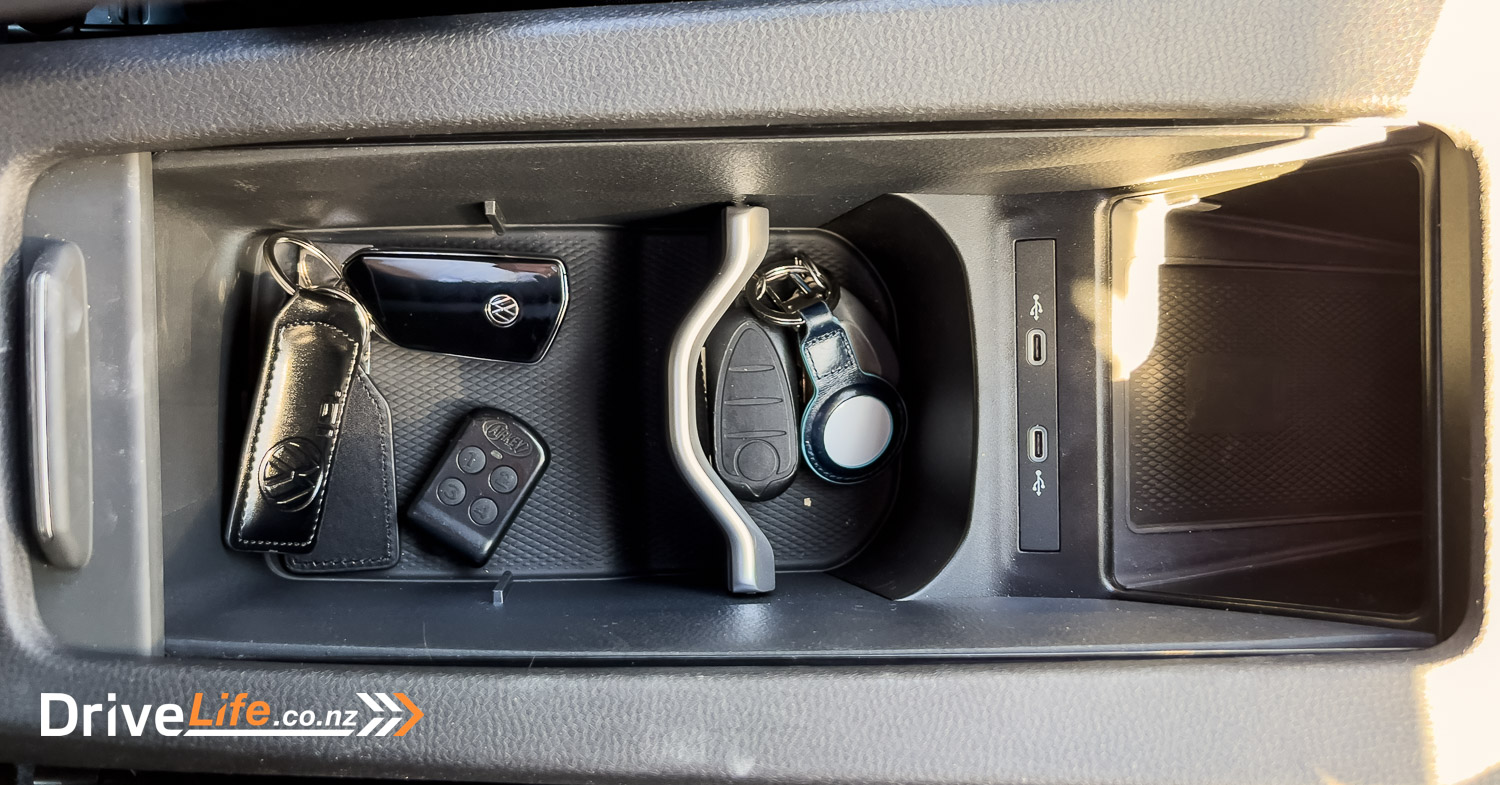
The rear seats have the same look and feel as the front, and when sitting in them both room and comfort are great. I’m not particularly tall but had no issue at all with ample legroom in front and headroom above.
At 545 litres, the rear boot space is at the larger end of the range for this sized vehicle and we certainly had no issues packing for a weekend away where we didn’t know exactly what we might need so we were not shy in saying “ah let’s just take this item just in case”. If your transport requirements are greater, the rear seats will fold down fully to give ample space, up to 1,575 litres. You also have the option of a traditional 60/40 split should you not require the maximum volume available.
Overall it’s a nice interior. It’s well made, looks good with a modern contemporary feel, and has nothing outlandish or over the top. I would not, however, expect that from a Volkswagen, so I’d say buyers are going to get exactly what they would expect. Functionality-wise, there are a few things to improve on, noticeably the infotainment system and certain touch controls, but overall I’d be happy spending long amounts of time in the ID.4
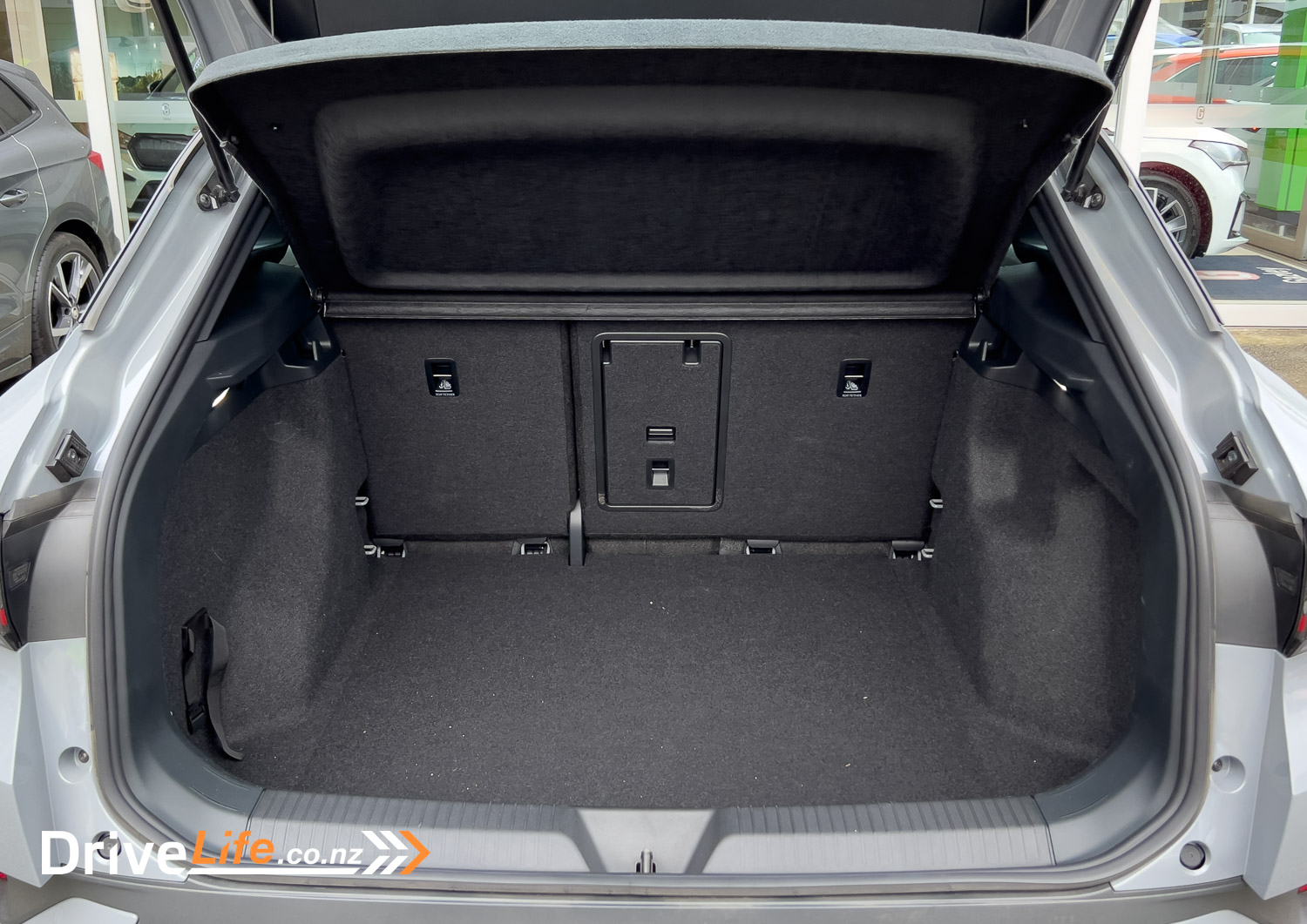
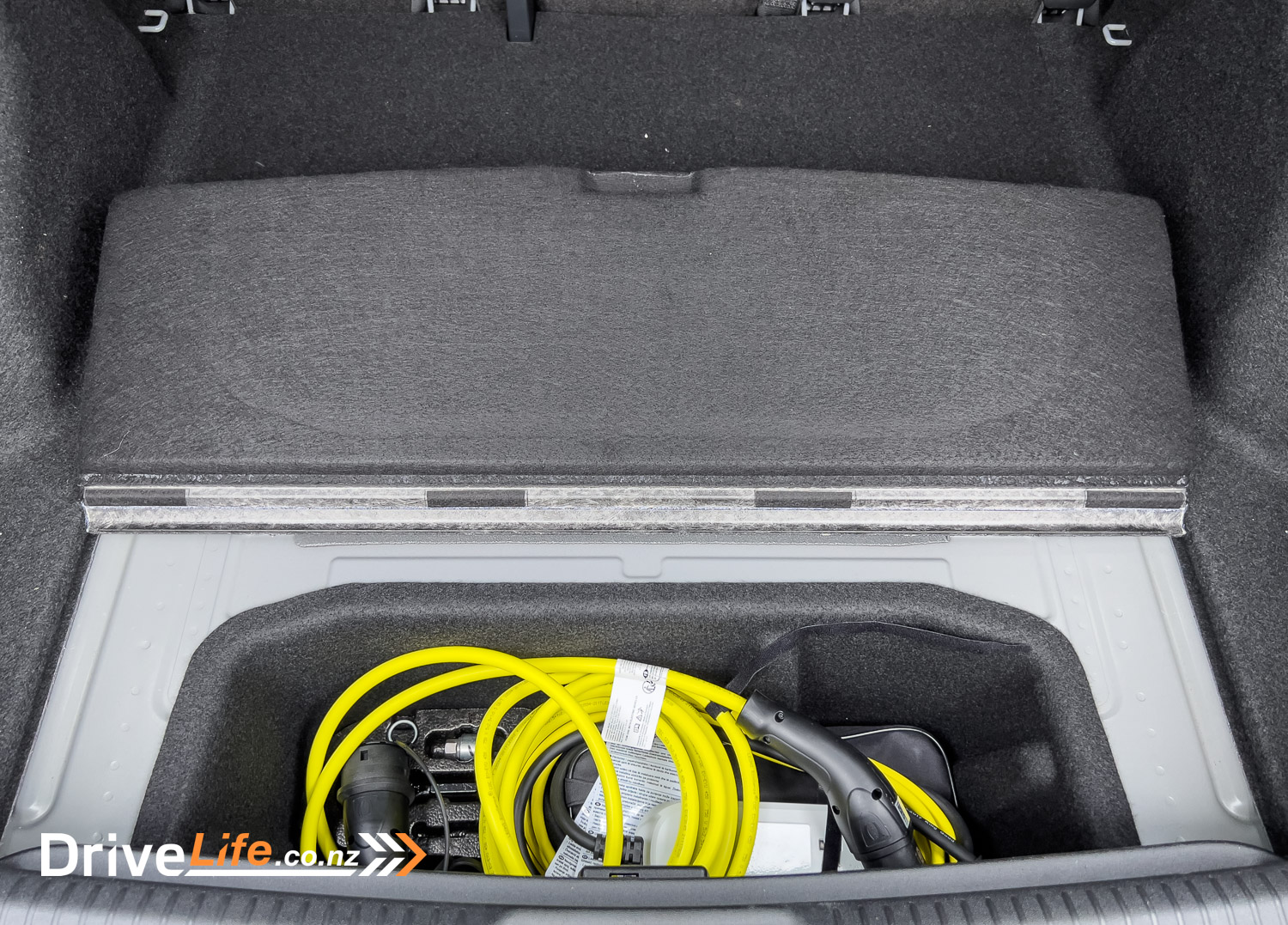
What’s The 2023 Volkswagen ID.4 PRO Like To Drive?
A quick trip into the local Volkswagen dealer on a Saturday morning to pick up the ID.4 and my wife and I were straight out of town on a weekend away to take in the sounds of Robbie Williams in Hawkes Bay. It’s a region of New Zealand where I felt the ID.4 would fit right in and is always a great place to visit.
We took a different route this time, heading up the centre of the island to Bulls and then cutting across to Hawkes Bay at Taihape, primarily as Tesla had just opened up their superchargers to other vehicles and I was keen to see how this worked given my previous experiences with the New Zealand charging infrastructure.
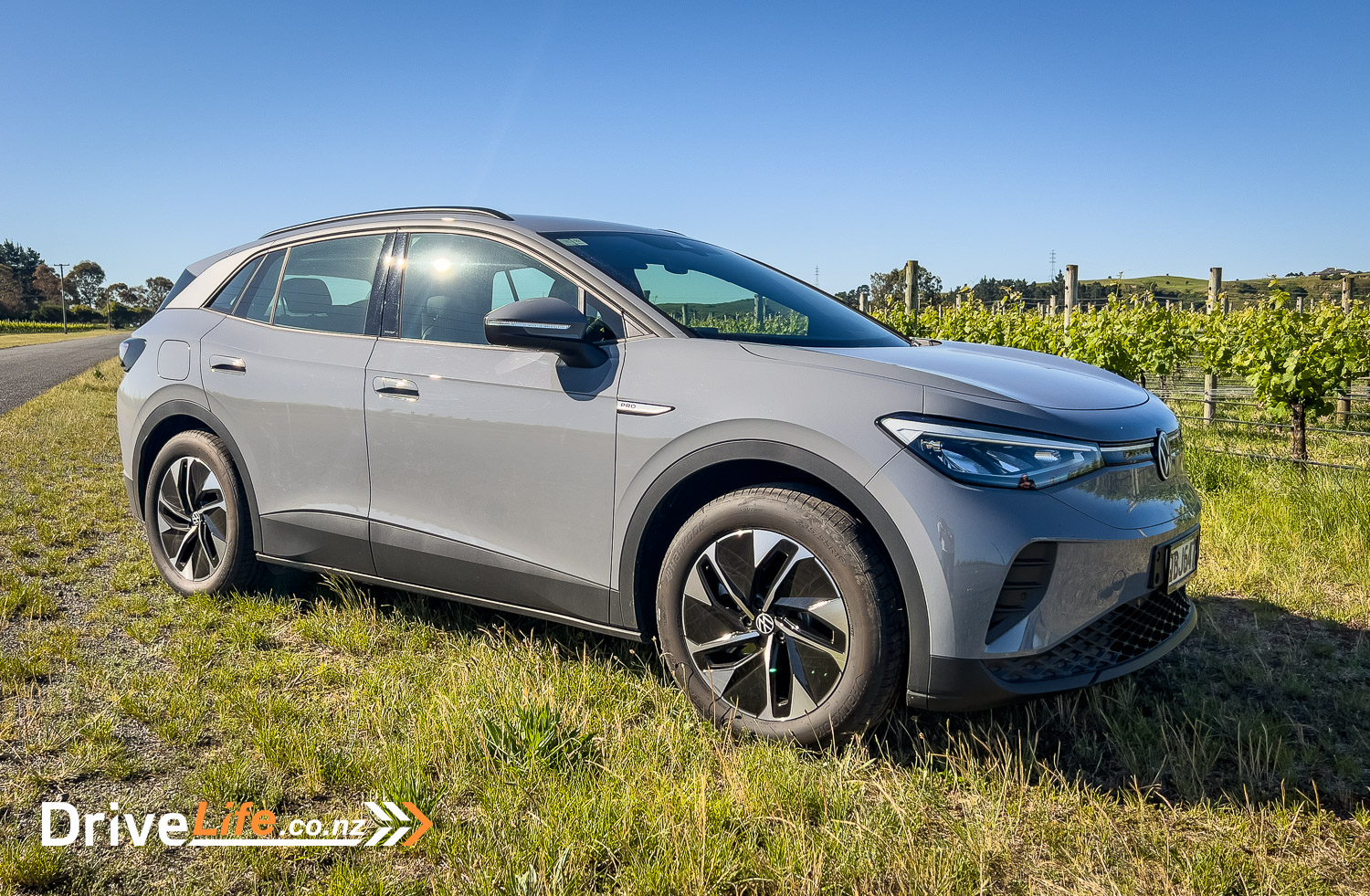
I’ve already spoken about the driving position in the interior section, so will jump straight into the driving. The ID.4 has keyless access, so beginning your journey is as simple as approaching the vehicle, opening the door and you are ready to go. To the right of the driver’s display is an integrated rotary switch. The central position is neutral, and rotating it clockwise engages drive mode and anti-clockwise reverse. When in drive, one more rotation clockwise will engage ‘B’ mode, which turns on the regenerative braking. There are no other options for the regen, it’s either on or off, but I found the level to be fine for my driving. At the end of the rotational control, you have a push button to engage the electronic parking brake and that’s all there is to it. It’s simple, functional, and works well.
Heading up the motorway on relatively flat and straight roads, the first observation is that the ID.4 is very quiet. The tyres give very little road noise despite the varying quality and condition of our main roads. Likewise, wind noise was almost nonexistent except for a small bit that appeared to be coming from between the A-pillar and the wing mirror. At 100 km/h, the ride is smooth and comfortable. The tyres are pretty compliant and combined with the damping and suspension system don’t transmit anything back into the car. The NVH engineers have done a good job on the MEB platform. Steering is a little light and vague for my liking, but this improves in sport mode and I ended up spending the majority of my time with it in this configuration.
Speaking of drive modes, in the ID.4 you have Eco, Normal, and Sport. This is another area I am starting to see a lot of similarity in E’s, in that there is not a lot of difference between drive modes compared to that which you see in a traditional internal combustion engine vehicle. I kind of understand this as you are limited by your electric motor and energy capacity so don’t want to drain it all super quick as you don’t have an instantaneous refill available. It would however be nice to see a bit more variety.
In case you hadn’t guessed, trying the different modes in the ID.4 resulted in little discernible difference. The steering is better in Sport and you notice a decline in power whilst in Eco, but in the big picture it is not much. Even keeping an eagle eye on instantaneous energy usage showed no meaningful difference when going from Normal to Sport mode. That being said, there was nothing wrong with the ID.4’s performance. In Normal mode, it had plenty of usable power and didn’t feel sluggish at all if you needed to use it to overtake.
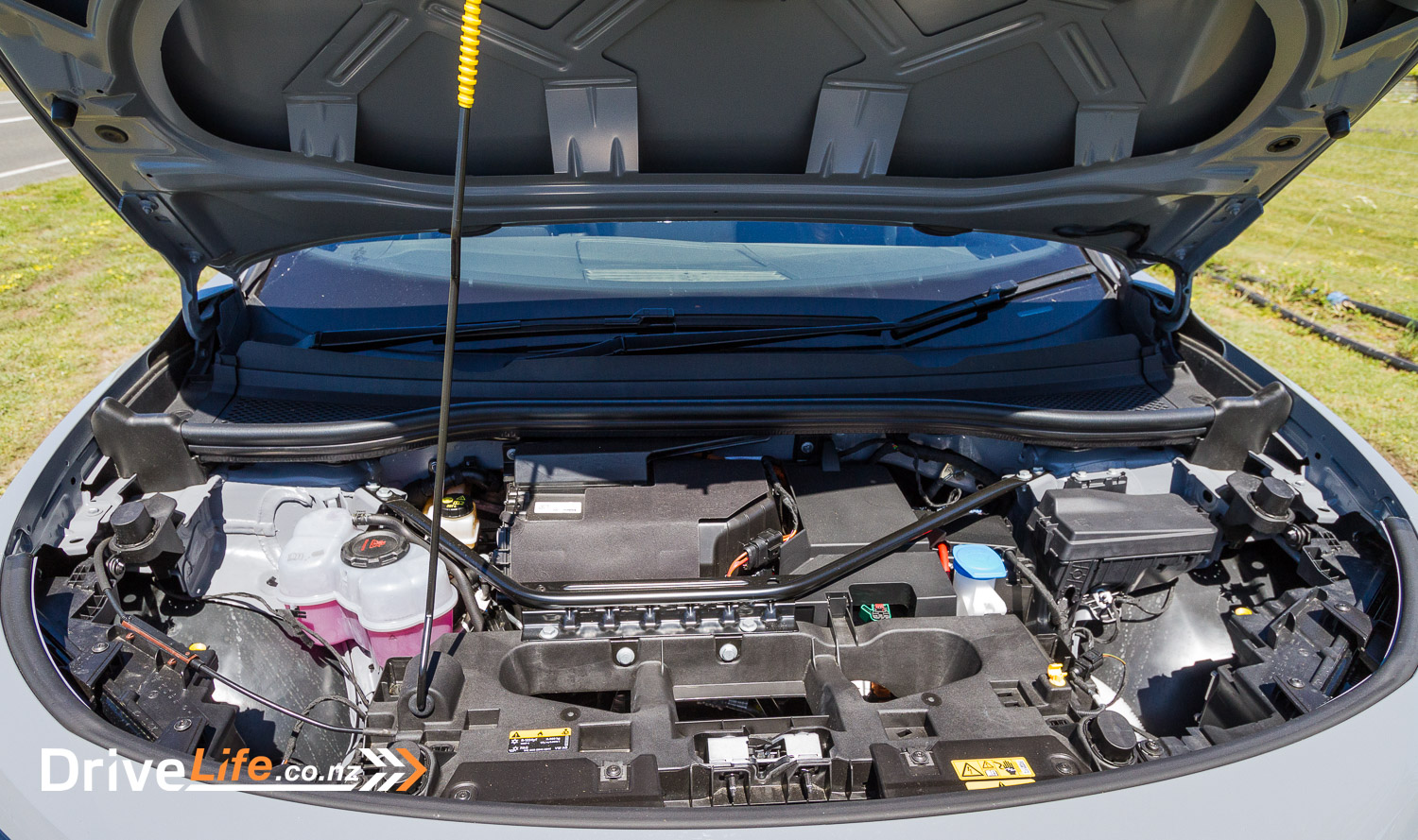
Arriving at Bulls after 150km and using 34% of the battery, I was looking forward to a fast top-up at the 250kW Tesla fast chargers. Despite being the only vehicle present, we topped out at 60kW. The ID.4 is rated to charge at up to 125kW, so I guess Tesla, while opening their chargers up, is limiting the speeds to rival manufacturers. Nevertheless, the charge was drama-free and we managed to get a bite to eat at a local cafe.
Heading on from Bulls, the roads are a bit more windy, and your typical New Zealand main highway that is not a highway. Here the ID.4 also performed well. I did notice however that on these windy and more undulating roads, you would feel a lot more of the weight of the vehicle. Tyre roll was much more noticeable and they were a little bouncy. The damping was also not spot on as you could feel the vehicle body floating a bit on the undulations and the dampers not stopping it quickly. I am very picky on this kind of stuff, so in reality, it is probably not a big deal at all, but when you are driving a vehicle that has no real bad points to mention, it’s these little things that I notice.
It’s worth mentioning that this was a bit better in Sport mode, and also in terms of road compliance the damping and springs seemed fine, it was just in heave (the up and down movement) and to a lesser extent roll that it was noticeable. The tyres at 235/55 x 19 on the front and 225/50 x 19 on the rear provided ample grip in the dry and gave good feedback. Surprisingly, we didn’t get the opportunity to try them in the wet.
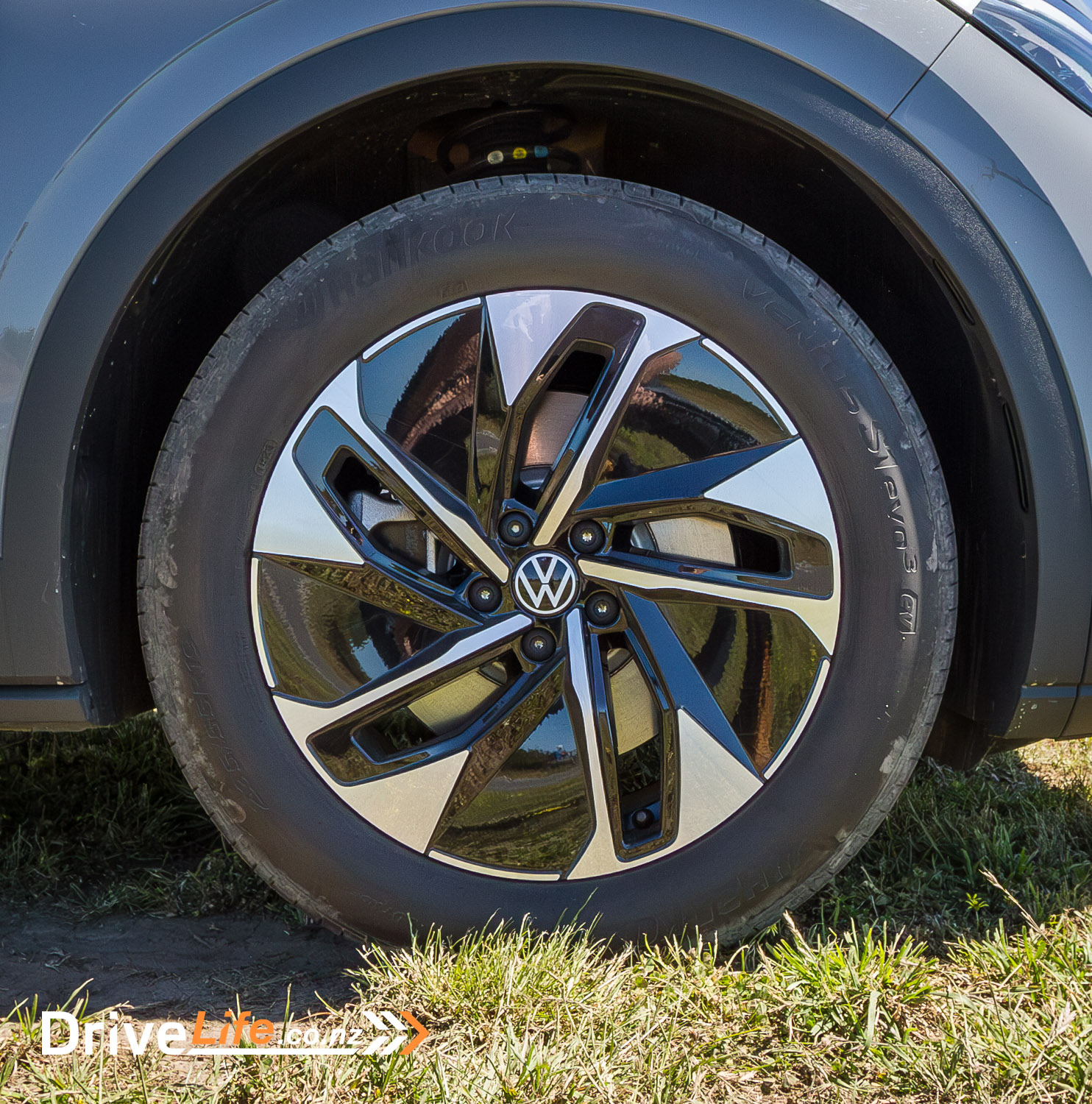
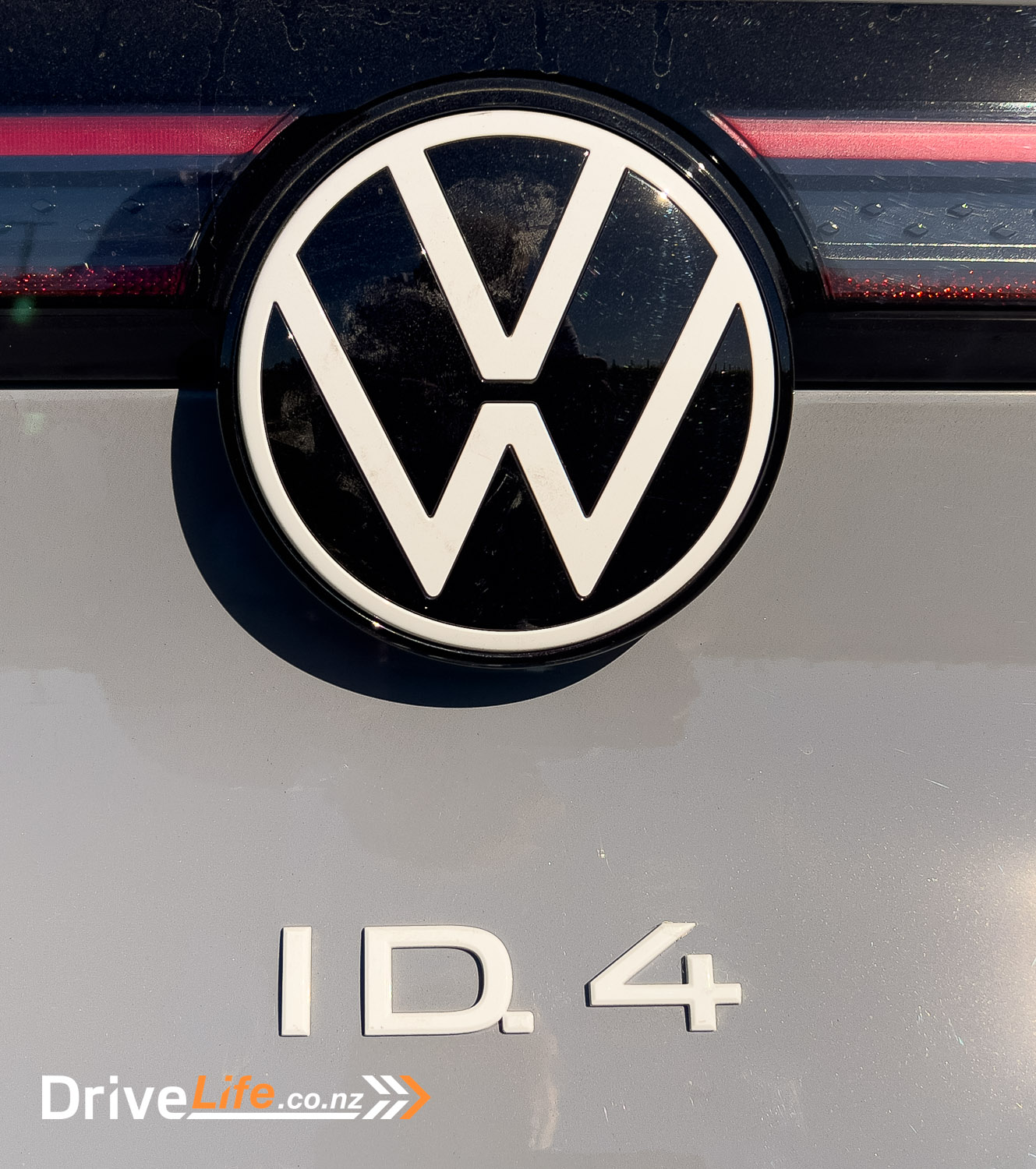
After a solid day of driving we arrived in the Bay, both feeling fine. The seats for the driver and passenger are really comfortable, and the cabin air conditioning works well. I’m always suspicious of dual-zone systems, as to me convection says the air will all mix as one in the cabin so I struggle to see the point of setting different temperatures. However my wife and I did this, were both happy with our selections, and both arrived feeling refreshed so I’ve got to say it’s a good climate control system.
Another thing I’m noticing on electric vehicles I’ve been driving lately is the lack of engine noise really does have an effect on your fatigue level on a long drive. I’m not a fan of stopping, preferring to just get in and drive till I’m at the destination. It’s occurred to me lately that I am feeling less worn out after a long drive, and the only thing I can put this down to is not having the engine drone for hours on end.
The remainder of our weekend’s open-road driving went pretty much the same way.
On the journey home we found ourselves spending a lot of time with the adaptive cruise control on. It proved to be very accurate and the logic of how to operate it was sound. However, we did have issues with the operation of the steering wheel touch controls, as outlined earlier. When they worked, it was great, but unfortunately, it was not often enough that they were operational.
The lane assist also worked well when engaged, and was not too intrusive as some can be. The ID.4 comes with Rest Assist, which is Volkswagen’s name for their driver fatigue detection system, that is becoming more and more popular these days. I always felt alert and awake during the week with the ID.4 and not once did I get an alert from the system. I’ll take this as a sign it was running well.
Visibility out the front, rear, and sides was fine, with no noticeable blind spots from the A,B, or C pillars. One peculiar thing I noticed was that the lower extremity of the brake pedal was very low to the floor. This gave a rather unnatural arc when operating for someone like me who tends to sit back with straighter legs as opposed to very close to the steering wheel and more bent legs, with my toes often hitting the bar coming down from the brake pedal pivot. It’s a very minor thing and potentially unique to me, but I did notice it a few times.
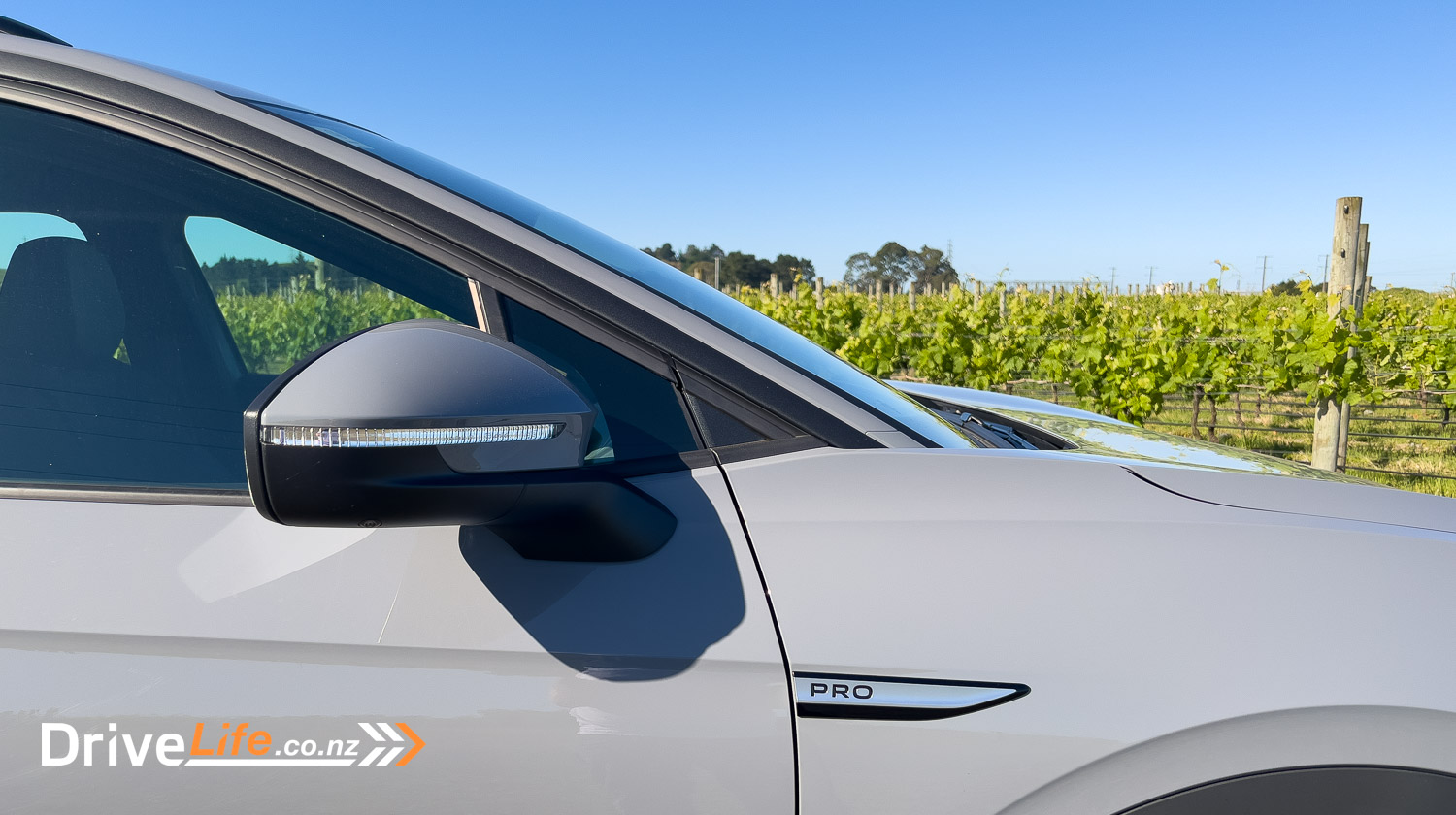
My final few days were spent driving around town and here again, the ID.4 displayed all the qualities that we had already found. It is quiet, comfortable and just did a good job. The only negative I did find was the turning circle; I have a particular spiral ramp leading out from where I park my vehicles. Despite having a respectable turning circle, advertised at 10.4m (which is lower than many similar vehicles I have driven) it struggled to get down this spiral in a fluid one-turn motion. I found myself having to slow right down to make it. I also have an often-used 3-point turn area, again the ID.4 struggled here.
During my week, all the peripherals unmentioned so far worked well, air conditioning kept the interior at a comfortable temperature, and I found myself not minding the swipe-activated temperature touch control. The air vents are in a good position, cup holders are nice and sturdy, and the charging pad for your cell phone is conveniently placed midway down the centre console. The driver’s instrument panel was clear and easy to read, despite my reservations about its size.
During a week in the ID.4 we managed just on 900km around the lower North Island and averaged 18.0 kWh/100km, higher than both the 16.9 kWh/100km Volkswagen advertise, and the 16.1 kWh/100km achieved in the Cupra Born.
2023 Volkswagen ID.4 PRO – Specifications
| Vehicle Type | Electric |
| Starting Price | $79,990 |
| Price as Tested | $79,990 |
| Engine | Single Electric Motor |
| Power, Torque kW/Nm | 150/310 |
| Transmission | Single Speed Reduction Gear |
| Spare Wheel | None – emergency inflation kit provided |
| Kerb Weight, Kg | 2,148 |
| Length x Width x Height mm | 4,582 x 1,852 x 1,637 |
| Boot Space / Cargo Capacity, Litres (seats up/seats down) | 543/1,575 |
| Battery Capacity, kWh | 77 |
| Energy Economy, kWh/100km | Advertised Spec – Combined – 16.9 Real-World Test – Combined – 18.0 Low Usage: 6-10 / Medium Usage 11-19 / High Usage 19+ |
| Towing Capacity Kg, unbraked/braked | 750/1,000 |
| Turning circle metres | 10.4 Small: 6-10m / Medium 10-12m / Large 12m+ |
| Warranty | 5 year / 150,000km mechanical warranty 5 year Roadside Assistance 12 year anti-corrosion warranty 8 year / 160,000km battery warranty |
| Safety information | ANCAP Rating – 5 stars Rightcar.govt.nz – 5 Stars |
Have you enjoyed this review? Be sure to join our monthly email newsletter list so you don’t miss a single car review!
END of REVIEW


